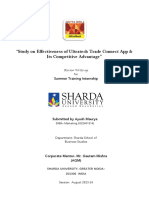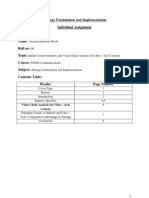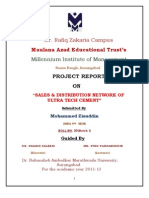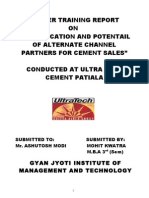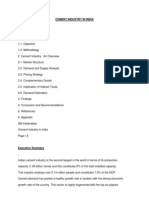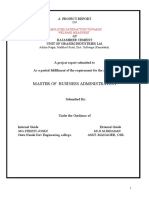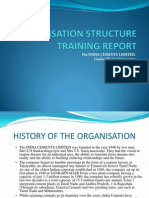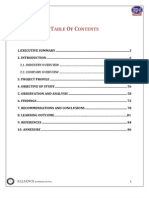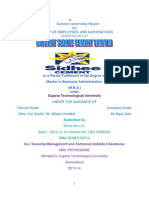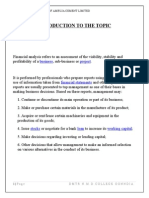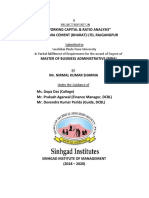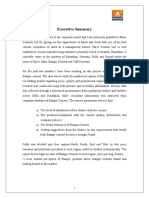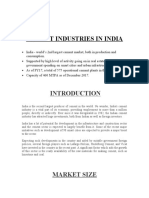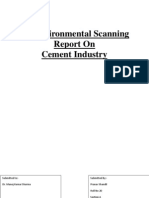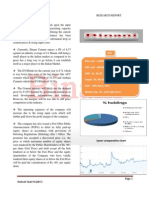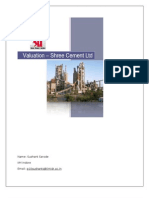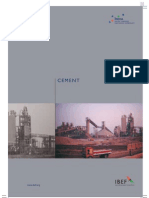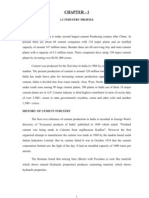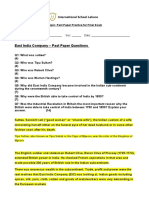Project Final - India Cements
Project Final - India Cements
Uploaded by
abhisekparijaCopyright:
Available Formats
Project Final - India Cements
Project Final - India Cements
Uploaded by
abhisekparijaCopyright
Available Formats
Share this document
Did you find this document useful?
Is this content inappropriate?
Copyright:
Available Formats
Project Final - India Cements
Project Final - India Cements
Uploaded by
abhisekparijaCopyright:
Available Formats
COMPANY PROFILE
MISSION STATEMENT of India Cements Ltd :
“We should be one of the largest Cement Companies in the Country. Our growth in size will
be through continuous review of potentials of the existing manufacturing resources, strategic
acquisitions and expansions”.
India Cements Limited(ICL) is a cement manufacturing company based in India. The
company was incorporated in 21 st February 1946 and the first plant was set up at Sankarnagar
in Tamil Nadu in 1949. The initial annual manufacturing capacity of 1 lakh tones was
gradually increased and reached 4.63 lakh tones by 1959. In August 1990 the wet process
technique of manufacturing was converted to dry process technique and the wet process kilns
were replaced with a modern single dry process kilns. On 10th April 1990, the Bureau of
Indian Standards (BIS) granted ICL the ISO:9001:2000 standard certification. It has seven
cement manufacturing plants/facilities spread over Southern India (Andhra Pradesh & Tamil
Nadu) catering to major markets in South India and Maharashtra. The capacities of its plants
are over 9 million tons per annum.
The company is the largest producer of cement in South India. It‟s plants are well spread with
3 in Tamil Nadu and 4 in Andhra Pradesh which cater to all major markets in South India
(Andhra Pradesh, Tamil Nadu Karnataka, Kerala) & Maharashtra. India Cements is the
market leader with a market share of 28% (approximately) in Southern India. It aims to
achieve 35% market share in the near future. The Company has access to huge limestone
resources and plans to expand capacity by de-bottlenecking and optimization of existing
plants as well as by acquisitions. It has a strong distribution network with 10000 stockists of
whom 25% are dedicated stockists. India Cements has well established brands like
Coromandel King, Coromandel Super Power & Rassi Gold.
GITAM INSTITUTE of INTERNATIONAL BUSINESS Page 1
The company was founded by :
Late.Shri S.N.N. Sankaralinga Iyer & Late.Shri T.N.Narayanaswami
And ICL is currently headed by Mr.N.Srinivasan , Vice Chairman and Managing Director.
The day-to-day affairs of the company are managed by Executive President Mr.
T.S.Raghupathy and other key personnel in each functional area.
The company has achieved its best ever performance both in terms of operational and
financial parameters in the 62 years history of the company. The clinker production for the
year 2007-08 of the company was at 72.13 lakhs tonnes while cement production was at
92.34 lakhs tonnes representing a capacity utilisation of 105% as compared to 84.24 lakh
tonnes in the previous year. Cement sales was also brisk at 92.15 lakh tonnes as against 84.14
lakh tonnes in the previous financial year.
The company‟s plants surpassed their best achievements in many fronts during 2007-08 :
Sankarnagar Plant achieved its highest clinker, cement and despatch during the year
of 11.80 lakh tonnes (11.72 lakh tonnes), 18.02 lakh tonnes (15.70 lakh tonnes) and
18.02 lakh tonnes (15.79 lakh tonnes) respectively.
Chilamakur Plant achieved its record clinker production of 11.19 lakh tonnes (11.17
lakh tonnes).
Dalavoi Plant achieved its best ever clinker, cement and despatches of 11.49 lakh
tonnes (10.90 lakh tonnes),12.72 lakh tonnes (11.45 lakh tonnes) and 12.67 lakh
tonnes (11.47 lakh tonnes) respectively.
Yerraguntla Plant again surpassed its record by clocking a clinker production of 5.39
lakh tonnes (5.01 lakh tonnes), cement grinding of 5.80 lakh tonnes (5.73 lakh
tonnes) and cement despatches of 5.80 lakh tonnes (5.73 lakh tonnes) respectively.
Vishnupuram Plant recorded its highest cement grinding of 25.11 lakh tonnes (24.02
lakh tonnes) and the despatches of 25.04 lakh tonnes (24.03 lakh tonnes).
The average output per kiln day showed an improvement of 5% at Sankarnagar, 3% at
Chilamakur, 4% at Dalavoi and 6% at Yerraguntla. In view of the rising freight costs
resulting in shooting up of coal prices on which the company is mainly dependent in
manufacturing cement. Approximately 60% of the company‟s requirements are met from
coal. With shipping prices touching almost record level highs , the company has revived its
shipping business with the purchase of two ships (DRY BULK CARRIERS ) with a total
GITAM INSTITUTE of INTERNATIONAL BUSINESS Page 2
capacity of 79843 DWT (Dead Weight Tonnage) which will be primarily utilised for captive
movement of coal and other raw materials also to partake in the upswing in the Shipping
Industry. This would ensure an uninterrupted supply of coal in case of disruption,
simultaneously paving way for reduced incidence of freight.
India Cements Ltd. also owns Indian Premier League's Chennai franchise, Chennai Super
Kings. During the year, the company has successfully bid for the Chennai Franchise of the
DLF-IPL 20/20 Cricket Tournament. “Chennai Super Kings”, as our Franchise is known, was
taken primarily with a view to promote the brand and to promote the Corporate Image.
Considering the plans to become a Pan India cement player, IPL would be an ideal platform
for India Cements Ltd. to launch their brands on an all India basis. The revenue stream for
this Franchise will consist of a share of central revenue and 100% of the local franchise
earnings. The company has also tied up with leading brands for team sponsorship and apparel
sponsorship and judging by the current trend, it will achieve huge brand promotion at
minimal cost.
Subsidiary companies of India Cements Ltd are :
ICL Securities Ltd.
ICL International Ltd.
ICL Financial Services
Industrial Chemicals & Monomers Ltd.
Trishul Concrete Products Ltd.
Coromandel Electric Company Ltd.
Unique Receivable Management Private Limited
Coromandel Sugars Ltd
India Cements Capital Ltd
Raasi Cement Ltd
GITAM INSTITUTE of INTERNATIONAL BUSINESS Page 3
INDUSTRY PROFILE
Overview :
The cement industry in India has been enjoying its best period with a healthy growth in
demand in the past two years. The industry has been operating at its near full capacity during
this period. The cement prices have been steady throughout the year with this firm demand
position.
The cement industry is one of the main beneficiaries of the infrastructure boom. With robust
demand and adequate supply, the industry has bright future. The Indian Cement Industry with
total capacity of 168 million tones is the second largest after China. Cement industry is
dominated by 20 companies who account for over 70% of the market. Individually no
company accounts for over 12% of the market. The major players like L&T and ACC have
been quiet successful in narrowing the gap between demand and supply. Private housing
sector is the major consumer of cement (53%) followed by the government infrastructure
sector. Similarly northern and southern region consume around 20%-30% cement while the
central and western region are consuming only 18%-16%.
The all India clinker production picked up further by 6.5% to 129.70 million tonnes as
compared to 121.75 million tonnes during the previous year. The overall production of
cement in the country for the year ended March 2008 was up at 168.31 million tonnes as
against 155.66 million tonnes in the previous year registering a growth of 8.1%. The
domestic consumption of cement grew further by 9.8% over and above the double digit
growth recorded in the previous two financial years and was at 164.02 million tonnes as
compared to 149.40 million tonnes in the previous financial year. The cement export was,
however, lower at 3.65 million tonnes as against 5.89 million tonnes in the previous year due
to a buoyant domestic market. The clinker exports were also lower at 2.37 million tonnes as
compared to 3.10 million tonnes in the previous year.
India is the second largest cement producer in world after china. Right from laying concrete
bricks of economy to waving fly over‟s cement industry has shown and shows a great future.
The industry looks healthy and promising & shows significant growth on the back of robust
demand from housing construction, Phase-II of NHDP (National Highway Development
Project) and other infrastructure development projects by both private, public & also by a
consortia of both. Domestic demand for cement has been increasing at a fast pace in India.
GITAM INSTITUTE of INTERNATIONAL BUSINESS Page 4
Cement consumption in India is forecasted to grow by over 22% by 2009-10 from 2007- 08.
Among the states, Maharashtra has the highest share in consumption at 12.18%,followed by
Uttar Pradesh, In production terms, Andhra Pradesh is leading with 14.72% of total
production followed by Rajasthan. Cement production grew at the rate of 9.1 per cent during
2006-07 over the previous fiscal's total production of 147.8 mt (million tons). Due to rising
demand of cement the sales volume of cement companies are also increasing & companies
reporting higher production, higher sales and higher profits. The net profit growth rate of
cement firms was 85%. Cement industry has contributed around 8% to the economic
development of India. Cement industry has a long way to go as Indian economy is poised to
grow because of being on verge of development.
Companies continue to emphasize on reduction of costs through enhanced productivity,
reduction in energy costs and logistics expenses. The cement sector is expected to witness
growth in line with the economic growth because of the strong co-relation with GDP. Future
drivers of cement demand growth in India would be the road and housing projects.
Cement industry in India has also made tremendous strides in technological up gradation and
assimilation of latest technology. Presently, 93 per cent of the total capacity in the industry is
based on modern and environment-friendly dry process technology. The induction of
advanced technology has helped the industry immensely to conserve energy and fuel and to
save materials substantially. Indian cement industry has also acquired technical capability to
produce different types of cement like Ordinary Portland Cement (OPC), Portland Pozzolana
Cement (PPC), Portland Blast Furnace Slag Cement (PBFS), Oil Well Cement, Rapid
Hardening Portland Cement, Sulphate Resisting Portland Cement, White Cement etc. Some
of the major clusters of cement industry in India are: Satna (Madhya Pradesh), Chandrapur
(Maharashtra), Gulbarga (Karnataka), Yerranguntla (Andhra Pradesh), Nalgonda (Andhra
Pradesh), Bilaspur (Chattisgarh), and Chandoria (Rajasthan).
Current Scenario :
India is the second largest producer of cement, which meets global standards. The cement
industry comprises 130 large cement plants and more than 300 mini cement plants. The
industry's capacity at the end of the year 2008 reached 188.97 million tons(approximately)
which was 166.73 million tons(approximately) at the end of the year 2006-07.It is estimated
that cement production would cross the 200 million tons mark by the year end of 2009.
GITAM INSTITUTE of INTERNATIONAL BUSINESS Page 5
Cement industry in India is currently going through a consolidation phase. Some examples of
consolidation in the Indian cement industry are:
a. Gujarat Ambuja taking a stake of 14 per cent in ACC, and taking over DLF Cements
and Modi Cements
b. ACC taking over IDCOL
c. India Cements Ltd. taking over Raasi Cement and Sri Vishnu Cement
d. Grasim's acquisition of the cement business of L&T, Indian Rayon's cement division,
and Sri Digvijay Cements.
Foreign cement companies are also picking up stakes in large Indian cement companies.
a. Swiss cement major Holcim has picked up 14.8 per cent of the promoters' stake in
Gujarat Ambuja Cements (GACL). Holcim's acquisition has led to the emergence of a
major group in the Indian cement industry, the Holcim-ACC-Gujarat Ambuja
Cements group.
b. Lafarge, the French cement major has acquired the cement plants of Raymond and
Tisco.
c. Italy based Italcementi has acquired a stake in the K.K. Birla promoted Zuari
Industries' cement plant in Andhra Pradesh, and
d. German cement company Heidelberg Cement has entered into an equal joint-venture
agreement with S P Lohia Group controlled Indo-Rama Cement.
A review of regional pattern of growth in cement demand reveals the following:-
REGION 2007-08 2006-07
North 12.17% 10.44%
East 5.65% 5.87%
South 9.71% 12.90%
West 14.00% 9.10%
Central 6.05% 8.90%
OVERALL 9.80% 9.90%
Source : ICL Website
It can be observed that south in which the company‟s main markets are situated has registered
a growth of 9.71% over and above 12.9% growth achieved in the previous year. This has
clearly paved way for more remunerative prices in the market.
GITAM INSTITUTE of INTERNATIONAL BUSINESS Page 6
GROWTH OF CEMENT INDUSTRY
Large Plants (1981 to 2008)
Capacity at the end Production Growth
Year Cement Production
of the year (%)
1981 28.93 20.77
1982 31.78 22.54 8.5
1983 35.86 25.41 12.7
1984 39.10 29.14 14.7
1985 41.85 31.11 6.8
1986 49.10 33.65 8.2
1987 54.51 36.97 9.9
1988 55.04 40.72 10.1
1989 56.36 42.07 3.3
1990 58.12 44.87 6.7
1991 60.61 49.47 10.3
1992 62.46 50.87 2.8
1993 66.90 52.78 3.8
1994 73.19 57.57 9.1
1995 82.06 62.08 7.8
1996 90.17 68.86 10.9
1997 99.92 74.75 8.6
1998 108.41 79.42 6.2
1999 109.44 91.72 15.5
2000 116.82 95.95 4.6
2001 133.55 98.35 2.5
2002 137.53 109.59 11.4
2003 140.07 111.35 1.6
2004 146.38 117.50 5.5
2005 153.59 127.5 8.60
2006 165.60 155.38
2007 171.95 163.25
2008 178.60 169.67
Source : ICL Website & Indiastat.com Combined
GITAM INSTITUTE of INTERNATIONAL BUSINESS Page 7
Taking into account a dormant capacity of 5 to 6 million tonnes, the industry has been
operating to its full capacity for the past two years resulting in more pockets of shortages in
the far flung areas of the country. The real unsatisfied demand in the country is yet to be
established as the industry has been measuring the demand based on the despatches made.
Given the thrust by the Government for the infrastructure development including roads, ports,
air-ports, power plants and special economic zones and also for housing, satellite township
and irrigation projects, it is believed that the cement demand will grow over 10% in the
future. This implies that significant capacity would be required to catch up with this growth
in demand and the new capacities have also been announced and are under creation towards
this end. However, given the delays that are occurring in the execution of new projects on
account of bottlenecks in the supply side of major equipments and availability of erection
contractors, delays in commissioning of new capacities cannot be ruled out and hence the
present buoyant situation is likely to continue till new capacity actually materializes to satisfy
the growth in demand.
On the fiscal side, the Government has taken a lot of measures in the previous year including
removal of import duty and CVD on cement and has also introduced slab rates of excise duty
of cement linked to Maximum Retail Price which has been further modified during the year
with increase in tariff rate from Rs.600 to Rs.900 per MT. However, given the buoyant
demand, the industry was able to pass on this impact to the consumer. During the year there
was a steep hike in the delivered prices of imported coal caused by the increase in freight and
increased demand for coal from developed countries. The CIF prices of imported coal which
was around 55 – 60 US dollars in March 2007 rose to a level of 110 – 120 US dollars towards
the end of March 2008 causing a huge adverse impact on the cost of production of cement for
many of the units relying on imported coal.
Scenario in Andhra Pradesh :
Andhra Pradesh, a South Indian state has a huge reserve of limestone and these are being
exploited by major plants & mini plants. Limestone the prime raw material for cement is
available in abundance in Andhra Pradesh. Other raw materials required for cement
manufacturing are coal, bauxite, gypsum & fly ash are also available in the state. One fourth
of the cement grade limestone reserves in the country are in Andhra Pradesh. Production wise
Madhya Pradesh is the largest cement producing state in the country followed by Andhra
Pradesh which is 18% of the total production.
GITAM INSTITUTE of INTERNATIONAL BUSINESS Page 8
Major cement manufacturers in India :
Ultratech Cements
ACC
India Cements Ltd.
Madras Cements
Lafarge
Jaiprakash Associates
Grasim Industries
Holcim
Italicementi
JK Cements
Birla Cements
Gujrat Ambuja Cement Ltd.
GITAM INSTITUTE of INTERNATIONAL BUSINESS Page 9
PRODUCT PROFILE
In cement production, raw materials preparation involves primary and secondary crushing of
the quarried material, drying the material (for use in the dry process) or undertaking a further
raw grinding through either wet or dry processes, and blending the materials. Clinker
production is the most energy intensive step, accounting for about 80% of the energy used in
cement Production. Produced by burning a mixture of materials, mainly limestone, silicon
oxides, aluminum, and iron oxides, clinker is made by one of two production processes: wet
or dry; these terms refer to the grinding processes although other configurations and mixed
forms (semi-wet, semi-dry) exist for both types. In the dry process, the raw materials are
ground, mixed, and fed into the kiln in their dry state. In the wet process, the crushed and
proportioned materials are ground with water, mixed, and fed into the kiln in the form of
slurry.
Different types of cement that are produced by India Cements Ltd are:
Ordinary Portland cement (OPC): OPC, popularly known as grey cement, has 95 per cent
clinker and 5 per cent gypsum and other materials. 3 grades of OPC are produced by ICL :
53 Grade OPC : 53 Grade OPC is a higher strength cement to meet the needs of the
consumer for higher strength concrete. As per BIS requirements the minimum 28 days
compressive strength of 53 Grade OPC should not be less than 53 MPa. For certain
specialised works, such as prestressed concrete and certain items of precast concrete
requiring consistently high strength concrete, the use of 53 grade OPC is found very
useful. 53 grade OPC produces higher-grade concrete at very economical cement
content. In concrete mix design, for concrete M-20 and above grades a saving of 8 to
10 % of cement may be achieved with the use of 53 grade OPC. It is mostly used in
paving blocks, tiles , building blocks , runways, concrete roads, bridges and similar
heavy constructions.
43 Grade OPC : 43 Grade OPC is the most popular general purpose cement in the
country today. The production of grade 43 OPC is nearly 50% of the total production
in the country. 43 Grade OPC‟s are generally used in general civil engineering works,
precast items such as blocks,tiles,asbestos sheets etc.
33 Grade OPC : This cement is used for general civil construction work under normal
environmental conditions. Due to low compressive strength, this cement is normally
not used where high grade of concrete is required. The availability of higher grades of
GITAM INSTITUTE of INTERNATIONAL BUSINESS Page 10
OPC in the market are affecting the use of 33 grade OPC and now a days 43 grade
OPC is normally used for general construction work instead of 33 grade OPC. More
useful for mass concreting and plain cement concreting. Normally made to order
basis. It can be used for plastering and single storied individual houses.
Portland Pozzolana Cement (PPC): PPC has 80 per cent clinker, 15 per cent pozzolana and
5 per cent gypsum and accounts for 18 per cent of the total cement consumption. It is
manufactured because it uses fly ash/burnt clay/coal waste as the main ingredient.
The Portland Pozzolana Cement is a kind of Blended Cement which is produced by either
inter grinding of OPC clinker along with gypsum and pozzolanic materials in certain
proportions or grinding the OPC clinker, gypsum and pozzolanic materials separately and
thoroughly blending them in certain proportions.
Pozzolana is a natural or artificial material containing silica in a reactive form. It may be
further discussed as siliceous or siliceous and aluminous material which in itself possesses
little, or no cementitious properties but will in finely divided form and in the presence of
moisture, chemically react with calcium hydroxide at ordinary temperature to form
compounds possessing cementitious properties. It is essential that pozzolana be in a finely
divided state as it is only then that silica can combine with calcium hydroxide (liberated by
the hydrating Portland Cement) in the presence of water to form stable calcium silicates
which have cementitious properties. The pozzolanic materials commonly used are:
Volcanic ash
Calcined clay
Fly ash
Silica fumes
In view of the availability of good quality fly ash in abundant quantity, the use of calcined
clay based pozzolana cement is progressively decreasing. The flyash is a waste product of
Thermal power Plant which create disposal problems at Thermal power plant site. The yearly
production of flyash in India is about 70 million tonnes per annum. This would increase in
future depending upon the new coal based thermal power plants to be installed in the country.
GITAM INSTITUTE of INTERNATIONAL BUSINESS Page 11
The present utilization of fly ash in production of blended cement in India is meagre.
Fly ash is the ash precipitated electrostatically from the exhaust fumes of coal fired power
station. The fly ash particles are spherical and are generally of higher fineness than cement so
that the silica is readily available for reaction.
The Portland Pozzolana Cement makes concrete more impermeable and denser as compared
to Ordinary Portland Cement. The long-term strength (90 days and above) of Pozzolana
cement is better compared to OPC.
The Portland Pozzolana Cement is ideally suited for the following construction.
a. Hydraulic structures
b. Mass concreting works
c. Marine structures
d. Masonry mortars and plastering
The compressive strength of PPC as is equivalent to that of 33 grade OPC. The major
quantity of flyash based PPC in India Cements Limited is presently being produced at
Sankarnagar and Sankari Works of India Cements Limited at Tamilnadu. However depending
of the requirement of flyash based PPC could be produced at all the Plants of India Cements
Limited in Tamilnadu and Andhra Pradesh. The PPC being manufactured by „India Cements
Ltd‟ meets the strength requirements of 53 grade.
GITAM INSTITUTE of INTERNATIONAL BUSINESS Page 12
CEMENT MANUFACTURING PROCESS
Lime stone is the basic raw material used in cement production. Good quality
limestone‟s are abundantly available in the mines owned by India Cements Ltd.
Limestone is obtained from the mines through the process of heavy blasting
conducted under strict supervision and safety precautions. The limestone herewith
obtained at India Cements Ltd. Mines are of very superior quality.
The limestone in the form on huge stones is loaded in the dumpers and are transported
to the crusher.
GITAM INSTITUTE of INTERNATIONAL BUSINESS Page 13
The dumper unloads the huge stones into the crusher. This machine is used to crush
the huge stones into smaller chunks of approximately 20mm in size.
Using accurate weighing machines the material is fed into a vertical roller mill. It is a
vertical steel mill with huge rollers used for grinding the material.
Powdered form of different grades is mixed homogenously in the blending silo.
GITAM INSTITUTE of INTERNATIONAL BUSINESS Page 14
The ground raw material is fed into a 6-stage pre heater where it meets the hot gases
rising from the Kiln. Pre-heating of material before calcinations is a crucial process as
it saves a lot of energy.
Calcination is the most crucial stage in cement manufacturing process. The raw
materials is fed into a kiln, which is a huge rotating furnace. Using coal as the fuel the
Kiln heats the raw material to a staggering temperature of 1400 degrees Celsius.
Subsequent to the intense heating, the raw material is sent to a cooler that brings the
temperature of the material down to 200 degrees Celsius. The sudden cooling of the
material results in the formation of grey colored nodules known as clinker.
GITAM INSTITUTE of INTERNATIONAL BUSINESS Page 15
Clinker which is prestructured reinforced cement concrete, is now sent to the clinker
silo to avoid weathering effects.
Clinker and gypsum are fed to a cement mill in definite proportions with the help of
weigh feeders. This procedure is popularly known as “Cement Mill”.
Then cement is packed in the packing plant into cement wags which weigh 50
kilograms each, with the help of automatic electronic packers and then are loaded into
trucks .
GITAM INSTITUTE of INTERNATIONAL BUSINESS Page 16
Once the cement is packed in its respective bags i.e different bags are used for PPC &
OPC type cements, they are directly loaded into trucks & train racks using conveyor
belts, this process is also a fully automated process.
During this whole manufacturing process, hourly samples are taken from manufactured
cement and is stringently tested at the shift labs in the plant. These check are to determine the
setting time and strength of the cement manufactured to keep the quality of the cement being
manufactured under constant observation.
GITAM INSTITUTE of INTERNATIONAL BUSINESS Page 17
LIVE PICTURES from TANDUR MANUFACTURING UNIT
Limestone Mines Dumper Unloading Limestone
Limestone Crusher kiln View
GITAM INSTITUTE of INTERNATIONAL BUSINESS Page 18
Company owned Railyard Preheater View
Control Room Calcinator
GITAM INSTITUTE of INTERNATIONAL BUSINESS Page 19
Cement Mill Clinker Silo
Quality Control lab Strength Tester
GITAM INSTITUTE of INTERNATIONAL BUSINESS Page 20
Packing Plant Conveyor Belt Bags dumped into trucks
Picturesque view of plant from mines Automated packer
GITAM INSTITUTE of INTERNATIONAL BUSINESS Page 21
NEED OF THE STUDY
As there are a large number of dealers dealing with India Cements Ltd. Products, the study
was conducted to know the dealers satisfaction towards India Cements Ltd. This in turn
enables the company to enhance its stringent competitiveness in the OPC & PPC Cement
market.
OBJECTIVES OF THE STUDY
1. To find the overall Dealer Satisfaction Level with India Cements Limited [ICL].
2. To find the logo awareness of Coromandel & Raasi Cement among customers.
3. To find awareness among customers that Coromandel & Raasi are brands of ICL.
SCOPE OF THE STUDY
1. The project is focused on randomly selected dealers in the twin cities of Hyderabad &
Secunderabad & as well as Mahbubnagar District.
2. The data collection is carried out in Hyderabad & Secunderabad for a period of 35
days in the twin citites & for a period of 1 day at Mahbubnagar District.
3. The project also focuses on the quality of India Cements Limited products as per
dealers view
4. The study helps to know the expectation of the distributors.
LIMITATIONS OF THE STUDY
1. Since the survey was done only in 2 places i.e Hyderabad & Mahbubnagar , the result
obtained may not be taken as universal suggestion.
2. Quality of the information is highly dependent on the knowledge of the respondents.
3. Concerned person of shop keeping in charge will always change, so their assessment
of the product & the relationship with the company officials could not be adequate.
GITAM INSTITUTE of INTERNATIONAL BUSINESS Page 22
TERMINOLOGY REVIEW
MARKETING is essentially about marshalling the resources of an organization so that they
meet the changing needs of customers on whom the organization depends. As a verb,
marketing is all about how an organization addresses its markets.
Marketing is “The management process which identifies anticipates and supplies customer
requirements efficiently and profitably”.
“Marketing is a total system of interesting business activities defined to Plan, piece, promote
and distribution want satisfying products & services to present and potential consumers”
- William. J. Stantion
“Marketing is the performance of business activities that direct the follow of goods and
services from the producer to the consumer or user”
- American Marketing Association
A social and managerial process, by which individuals and groups obtain what they need and
want, through creating and exchanging product and value with others. Customer satisfaction
begins with a difficult faith; it starts with a commitment to deliver the result for each
customer which is also a concern of the dealers. Hence for a manufacturing company, in
order to satisfy its customers, it is highly important to satisfy its dealers, as they are the direct
customers to them. Establishing satisfaction as the ultimate goal is like the other ultimate
goals of business pursuit of higher profits or shareholders wealth. Perfect dealer service or
satisfaction is one that meets the combined need satisfaction is a systemized service that
involves the entire organization. But many organizations have yet to develop this kind of
awareness of dealer satisfaction strategy.
DEALER SATISFACTION begins with the following specific assumptions about
company‟s relationship with the customers.
1. The dealer service activities focus mainly on existing dealers.
2. Some dealers are more important than others
3. They are the assets.
GITAM INSTITUTE of INTERNATIONAL BUSINESS Page 23
4. The dealer is always specific.
The dealer needs and value should influence every aspect of the organization strategy,
employee safety and performance, product and organization strategy, employee safety and
performance, product and service development, sales and marketing programs, operational
procedures and information and measurement system.
Understanding the dealer is critical to the success of any customer focus initiative, the first
step in understanding the dealers is to listen to them. A company needs to hear what its
dealers are saying about its people, product service and vision. Their information helps to
develop meaningful product and service.
Organizations need to listen to their dealer satisfied, dissatisfied neutral and prospective. As
one company executive said, “talking to a satisfied customer is talking to myself”. In the past,
dealer satisfaction and service was the responsibility of a separate organization that supported
the dealer primarily after the sale. Today, service is also likely to be interested with the every
product accompany offers. High dealer satisfaction comes from providing effective services.
But giving that service is a continuous activity. It means being efficient, reliable, courteous,
curing and professional every time.
Considering the fact that the way in which a dealer is treated by its manufacturer has decisive
influence on the dealer‟s commitment to the brand as well as on the dealer‟s business success,
an examination of dealer satisfaction or dissatisfaction has become strikingly important
during the last few years.
LOGO & ITS SIGNIFICANCE
“If image is everything then your company’s logo is its first impression.”
Before any knowledge of the company has been acquired, perceptions have already
been formulated based off of the logo.
While it may be difficult to pin down what it is that makes a great logo there certainly are
some common characteristics that all great logos share. The majority of logos consist of but a
GITAM INSTITUTE of INTERNATIONAL BUSINESS Page 24
single color, typically a primary color. Some may have two colors, but rarely do we see more
than two colors. This makes it easy to attach an emotion to a logo.
Together the eyes and brain produce a cognitive and emotional response to each color.
Because of this, colors themselves take on meanings. The exact meaning is often a cultural
understanding and can have multiple meanings across cultures. In the UK, white is
considered pure and positive where in China, white is used in mourning, symbolizing heaven.
Red is often used to symbolize strength and life, but is taboo in financial communities. Some
color meanings in the North America, Canada, and Western Europe include: Blues are said to
be calming, loyal and trustworthy, greens are healthy, wealthy and natural while reds express
passion, excitement or danger. Finally, it‟s also advantageous to use a single color for logo as
it will save money when it comes to placing it on different medium.
One thing remains constant - change. The constant evolution of media and information
delivery systems of today‟s times means that a logo will likely take on more than one form of
medium in its lifespan. Because of the likeliness that the logo will be found on more than just
print it‟s best to use clean lines. You don‟t see drop-shadows or beveling being used. This
allows for the logo to be easily placed on billboards, on business cards, on black and white
fax copies, mugs, t-shirts, mouse pads and all the rest.
We can take a few logos and analyse it, for example FedEx
The designer of the FedEx logo had embedded an arrow into its logo. If we concentrate and
look between the letters E & X you can see an arrow which shows speed and agility. These
are really well crafted logos which define the company and its product or services with just a
picture.
A logo should be able to convey its message over a prolonged period of time and it must be
able to adapt to cultural changes. It might be exciting to design a logo that is influenced by a
trendy typeface, but it will become outdated and need to be replaced in later years.
BRANDING & BRAND AWARENESS
Branding is more than just a business buzzword. It has become the selling of product in the
new economy. If the old marketing mantra was, “nothing happens until somebody sells
GITAM INSTITUTE of INTERNATIONAL BUSINESS Page 25
something, “the new philosophy could be “nothing happens until somebody brands
something.”
In its simplest form, a brand is a noun. It is the name attached to a product or service.
However, upon close inspection, a brand represents many more intangible aspects of a
product or a service: a collection of feelings and perceptions about quality, image, lifestyle
and status. It creates in the mind of the customers and prospects the perception that there are
no products or services in the market that is quite like yours. In short a brand offers the
customers a guarantee and then delivers on it.
A brand is the one thing that you can own that nobody can take away from you. Everything
else your competitor can steal your trade secrets. Eventually, your patents will expire,
physical plant will wear out, and technology will change, but my brand can go on and live. It
creates a lasting value above and beyond all the elements of my business. For instance, if we
owned the Marlboro Company and wanted to sell it. They are worth a small fraction of what
you can sell that brand; the value of the brand is huge compared to those actual physical
assets.
A brand is a collection of experiences and associations connected with a service, a person or
any other entity. Brands have become increasingly important components of culture and the
economy, now being described as "cultural accessories and personal philosophies. Some
people distinguish the psychological aspect of a brand from the experiential aspect. The
experiential aspect consists of the sum of all points of contact with the brand and is known as
the brand experience. The psychological aspect, sometimes referred to as the brand image, is
a symbolic construct created within the minds of people and consists of all the information
and expectations associated with a product or service.
People engaged in branding seek to develop or align the expectations behind the brand
experience, creating the impression that a brand associated with a product or service has
certain qualities or characteristics that make it special or unique. A brand is therefore one of
the most valuable elements in an advertising theme, as it demonstrates what the brand owner
is able to offer in the marketplace. The art of creating and maintaining a brand is called brand
management.
Careful brand management, supported by a cleverly crafted advertising campaign, can be
highly successful in convincing consumers to pay remarkably high prices for products
which are inherently extremely cheap to make. This concept, known as creating value,
essentially consists of manipulating the projected image of the product so that the consumer
GITAM INSTITUTE of INTERNATIONAL BUSINESS Page 26
sees the product as being worth the amount that the advertiser wants him/her to see, rather
than a more logical valuation that comprises an aggregate of the cost of raw materials, plus
the cost of manufacture, plus the cost of distribution. Modern value-creation branding-and-
advertising campaigns are highly successful at inducing consumers to pay.
A brand which is widely known in the marketplace acquires brand recognition. When brand
recognition builds up to a point where a brand enjoys a critical mass of positive sentiment in
the marketplace, it is said to have achieved brand franchise. One goal in brand recognition is
the identification of a brand without the name of the company present.
Consumers may look on branding as an important value added aspect of products or services,
as it often serves to denote a certain attractive quality or characteristic (see also brand
promise). From the perspective of brand owners, branded products or services also command
higher prices. Where two products resemble each other, but one of the products has no
associated branding , people may often select the more expensive branded product on the
basis of the quality of the brand or the reputation of the brand owner.
When should you brand?
Because of the competitive nature of business today, nearly all the industries can benefit from
branded products. All of the traditionally brand-conscious including fashion, restaurants and
consumer goods, are being forced to brand heavily perhaps even more strategically then they
ever have in the past. Financial services, which were one of the last effronteries, are even
beginning to see the importance of branding by tagging banking packages and even mutual
funds with catchy names. Even industrial market, where the cost is usually more of loyalty
building factor, has seen brand names creep in, for example, Tyke, a DuPont fiber,
improbably one of the best-known industrial branded products. Similarly, JCB has
recognized name in the construction industry.
Types of brands:
A brand cannot be all things to all people, by definition; NO one brand is going to appeal to
all customers. On the contrary, branding is based on the concept of singularity – targeting
individuals in a personal manner – and therefore precludes the concept of universal appeal.
This is why many brands broaden and widen their appeal by creating tertiary brands or line
extenders. Although most industries and products or services can benefit from a brand not
every product needs its own stand-alone brand. Brand can be separated into three categories.
GITAM INSTITUTE of INTERNATIONAL BUSINESS Page 27
Primary brands – This is a company‟s core brand or umbrella brand. Primary brand typically
garner a large percentage of a company‟s revenue potential and therefore needs to be given
priority of advertising in order to root them firmly.
Secondary brands- These are often line extenders or flankers for a core brand. They don‟t
need to have their own name; usually modifier to the brand name will suffice and strengthen
the core brand. Take, for instance, a toothbrush called the crest deep sweep. Crest is the core
brand and deep sweep is the secondary brand.
Tertiary brands- These brands typically have insignificant revenue potentials or expectations
but they contribute to the company‟s overall image in some way. Therefore they sometimes
don‟t sport registered brand names, but just descriptors. For example, a garbage bag
manufacturer may a generic brand bag in addition to its flagship brand the generic line may
bring n minimal revenue for the company. But it fills the need within a niche market so the
company continues to manufacturer it under the unregistered name Household Trash bags.
Therefore, the generic line is considered a tertiary brand for this company.
Brand identity is comprised of:
1. PRICING: A component of value; higher prices may signify to consumers higher quality
and lower prices may suggest decreased value.
2. DISTRIBUTION: Availability; limited distribution of a product or service may imply
exclusivity to discerning consumers.
3. QUALITY: Which impacts satisfaction; obviously, higher quality will translate to more
satisfied customers who come back again and again to purchase my offerings.
4. PRESENCE: Prominence in the paid & unpaid media; products and services with a high
profile market presence will lead to brand recognition and increased sales
5. AWARENESS: Top off mind awareness, residual awareness and recognition, which are
directly related to presence; the higher your offerings awareness the better my sales results
will be.
GITAM INSTITUTE of INTERNATIONAL BUSINESS Page 28
6. REPUTATION: Enduring public opinion of brand character, which is built over time and
difficult to change once established.
7. IMAGE: Perception of brand traits or prototypical buyers; often represented by qualities
the consumers relates to, like reputation, image is difficult to change once established.
8. BENEFITS: Consumers may equate certain positive and negative consequences with use of
your product or service these may be warranted or unwarranted.
9. POSITIONING SILENCE: Differentiation from the competition, which is established by a
combination of all elements of the brand.
10. SHARE OF MARKET: Increased market share is a direct result of a successful branding
campaign.
11. CUSTOMER COMMITMENT: Loyalty is built through long term branding and close
consumer contact.
GITAM INSTITUTE of INTERNATIONAL BUSINESS Page 29
RESEARCH METHODOLOGY
Meaning of Research
The term „research‟ is composed of two words „RE‟ and „Search‟ which means to search
again. Research is conducted to search for new facts or to modify the existing facts. The
obvious function of research is to add new knowledge to the existing store as well as to
remove the misconceptions and ignorance of mankind. Thus, research is a process and means
to acquire knowledge about any natural or human phenomena. It is the pursuit of the truth
with the help of study, observation, comparison and experiment.
Definition of Research
“Research is the process of systematically obtaining accurate answers to significant and
pertinent questions by the use of the scientific method of gathering and implementing
information.”
By Clover and Balsely
“Research is a method of studying, analyzing and conceptualizing social life in order to
extend, modify, correct and verify knowledge whether that knowledge aids in construction of
theory or in practice of an art”
By P.V.Young
Types of Research
There are three type of research on the basis of purpose:-
1. Descriptive Research:- This kind of research merely describes and depicts the current state
of affairs of different variables. The research has no control over these variables. He only
reports what has happened and what is happening. E.g :-Census in India
2.Exploratory Research :- This research attempts to gain better understanding of different
dimensions of the problem. It studies the subject about which either no information or a little
information is available. In this kind of research the assumption is that the researcher has
GITAM INSTITUTE of INTERNATIONAL BUSINESS Page 30
little or no knowledge about the problem or situation under the study. Exploratory studies are
appropriate for some persistent phenomena like sickness of an industry, deficiencies in
education system, corruption prevailing in government departments, rural poverty and so on.
3.Explanatory Research :- This kind of research explains the causes of social and economic
phenomena. Describing or exploring the nature of a phenomena is one thing but explaining
the cause for the same is its explanatory aspect. E.g :- what are the cause for decline in
productivity and profitability of a business, why and What are the causes of industrial
backwardness of a state.
Meaning of Research Design
Research design is a working plan prepared by the researcher before the actual start of
research work. It is the conceptual structure within which research activity is conducted. It is
a strategic plan of research. Research design includes an outline of what the researcher will
do from writing the hypothesis and its operation to collection, analysis and interpretation of
data.
E.g :- A house builder prepares a blueprint of the entire building before commencing the
actual construction.
Types of Research Design
1. Exploratory design: - The main objective of exploratory studies is to achieve new insights
into phenomena. The major emphasis in these studies is on the discovery of new insights and
ideas. They are mostly carried out when the researcher has either no knowledge or a limited
knowledge about the phenomena under study.
E.g :- The impact of television on behavior of youth, Impact of globalization on Indian
culture and social life.
2. Descriptive design: - The descriptive research design enables the researcher to describe a
present picture of a phenomenon under investigation. The methodology involved in such
designs is mostly quantitative in nature producing descriptive data. 2. Descriptive design: -
The descriptive research design enables the researcher to describe a present picture of a
phenomenon under investigation. The methodology involved in such designs is mostly
quantitative in nature producing descriptive data.
GITAM INSTITUTE of INTERNATIONAL BUSINESS Page 31
3. Diagnostic design: - A diagnostic study is directed towards the solution of a specific
problem by the discovery of relevant variables or causes that are associated with the problem
in varying degrees. It consists of :
a. The emergence of a problem
b. A diagnosis of its causes
c. Formulation of all the possible of remedial measures
d. Recommendations for a possible solution.
E.g:- This study may at discovering or analyzing the specific problems of farmers, college
teacher, or working women or pensioners. It‟s aim to identify the relevant variables
associated with the problem.
4. Experimental design: - It is a design in which some of the variables being studied are
manipulated. It is a design which seeks to control conditions within which persons are
observed. Here control means holding one factor constant while others are free to vary in the
experiment. One variable is manipulated are its effect upon another variable is measured,
while other variables which may confound such a relationship are eliminated or controlled.
The purpose of experimental studies is to test a hypothesis of casual relationship between
variables.
Meaning of sample
A part of the population which is studied for making judgment about the entire population is
called a sample. Different Methods of drawing a sample out of a given population have been
developed by the statisticians. These methods with the help of which a sample is drawn out of
a given population are called as a techniques of sampling.
Types of Sampling
Probability Sampling
1. Simple random sampling
2. systematic random sampling
3. stratified random sampling
GITAM INSTITUTE of INTERNATIONAL BUSINESS Page 32
4. cluster sampling
Non-probability sampling
1. Convenience sampling.
2. Judgment sampling.
3. Quota sampling.
4. Snowball sampling
Meaning of Data Collection Method
The collection of data means a purposive gathering of information relevant to the subject-
matter of investigation from the unit of population under investigation. Collection of data
makes the most important step of any research enquiry or statistical enquiry. If data collection
is not correct, reliable, relevant and appropriate, one cannot obtain valid and useful result
from the enquiry.
Types of Data
Primary Data: - If the investigator collects the data originally for the investigation, the data is
called primary data.
Secondary Data: - If this investigator does not collect the data originally but uses data
collected by other investigator or agency and available in published or unpublished form, the
data is called secondary data.
Methods of collecting Primary Data
1. Observation Method.
2. Interview Method.
3. Mailed questionnaire Method.
4. Questionnaire (or schedule) sent through enumerators.
5. Information from correspondents.
GITAM INSTITUTE of INTERNATIONAL BUSINESS Page 33
Method of Collecting Secondary Data
Published Sources
a. Government Publications
b. Publications of Universities and Research Institutions
c. Publications of commercial and Financial Institutions
d. Reports of Committees and Commissions
e. Newspapers and Periodicals
f. Internet
Unpublished Sources
All statistical material is not always published. Such records are maintained by various
government, post offices and research institutions. Such sources can be used where
necessary.
THEORY OF CROSS-TABULATIONS:
Researchers often seek to explain why a certain variable varies. This variable of interest is the
dependent variable. For example, a researcher might be interested in why some people favour
gun control, while others do not. The distribution of a dependent variable is the relative
frequency of each value of the variable (simply put). Hence, if 46.6% of survey respondents
favour a ban on guns, while 53.4% oppose it, this is the distribution of the researcher‟s
dependent variable. A researcher then forms a theory of what causal factor might affect the
dependent variable, and the measurement of this causal factor is the independent variable. A
researcher might reason that, all else equal, a person will trust the leaders of his or her party
on an issue. Since Republican leaders almost universally argue against gun control, while
many Democratic leaders favour it, there should be less support for a gun ban among
Republicans when compared to Democrats. The researcher could then choose a survey
respondent's self-reported party identification to test the hypothesis that Republicans will be
less supportive of a gun ban than Democrats.
GITAM INSTITUTE of INTERNATIONAL BUSINESS Page 34
A cross tabulation tests the hypothesis that an independent variable has a causal effect by
comparing the distribution of the dependent variable for each category of the independent
variable. The researcher asks: Will certain values of the dependent variable be noticeably
more or less frequent when moving from one category of an independent variable to another?
If the example researcher observes that 52.9% of Democrats favor a gun ban, while 37.9% of
Republicans favor this ban, then he or she might conclude that a 15% difference in the
frequency of this survey answer suggests that the distribution of opinion on gun control for
Democrats is different from the distribution of Republicans. Further, support for a gun ban
decreases moving from Democrats to Independents and from Independents to Republicans, as
expected. The researcher could conclude, then, that partisanship affects opinion on gun
control. When organizing a cross-tabulation, follow three important rules:
1. Use the independent variable to define a table‟s columns and the dependent variable
to define the rows. Include raw frequencies in parentheses in each cell and sum-up
total frequencies for each row and each column.
2. Always break-down percentages within categories of the independent variable. Many
people make a mistake by breaking-down percentages within categories of the
dependent variable; such a mistake prevents a researcher from testing the true
hypothesis that the independent variable causes the dependent variable and not the
reverse.
3. In interpreting results, compare the percentages across columns at the same value of
the dependent variable.
Some common mistakes to avoid: First, avoid breaking-down percentages by the dependent
variable (see rule 2). Second, avoid comparing the largest percentage in each category of an
independent variable: The hypothesis states that the frequency of the dependent variable will
vary by value of the independent variable; it does not argue what value of the dependent
variable will be most frequent. Lastly, avoid drawing inferences based on the pure magnitude
of percentages; the researcher‟s task is to look at differences in the distribution. For example,
even if 80% of Democrats and 60% of Republicans had expressed support for a gun ban, the
researcher should not focus on majority support in both categories, but conclude that a 20%
difference implies that partisanship importantly affects gun control opinion.
GITAM INSTITUTE of INTERNATIONAL BUSINESS Page 35
ANALYSIS OF THE STUDY
The study focuses of finding the dealer satisfaction levels, awareness among customers that
Coromandel and Raasi are brands of India Cements Ltd & significance of Logo recall of both
Coromandel & Raasi.
I used the following research analysis methods :
a. Frequency Distribution method
b. Cross Tabulation method
GITAM INSTITUTE of INTERNATIONAL BUSINESS Page 36
FREQUENCY TABLES & RESPECTIVE PIE CHARTS for HYDERABAD&
MAHBUBNAGAR MARKET
*Identify the tenure of dealership among the samples surveyed.
Here I am comparing the tenure ship of dealership of randomly picked up dealers for
Hyderabad market & Mahbubnagar market. 100 & 15 samples were take into consideration
for Hyderabad & Mahbubnagar respectively.
Option 1 : 1 to 3 years. Only 3% of the samples are in Hyderabad & 0% were found in
Mahbubnagar.
Option 2 : 4 to 7 years. 31% of dealers in Hyderabad were of a tenure raning from 4 to 7
years & 33.33% in Mahbubnagar.
Option 3 : 8 to 10 years. 28% of the dealers in Hyderabad fall into this category where as
40% in Mahbubnagar fall into this category.
Option 4 : more than 10 years. 38% dealers fall into this category in Hyderabad whereas
26.67% dealers fall into this category in Mahbubnagar.
What we can infer from here is Hyderabad has maximum number of dealers who are as old as
more than 10 years , whereas in Mahbubnagar maximum number of dealers fall into the
category of 8-10 years, which shows mahabubnagar is a budding market for ICL &
Hyderabad is a cash cow market for ICL.
GITAM INSTITUTE of INTERNATIONAL BUSINESS Page 37
* Identify product quality rating by dealers in Hyderabad & Mahbubnagar.
In this question 5 options were there for answers :
1. Very Good Quality
2. Good Quality
3. Average Quality
4. Bad Quality
5. Very Bad Quality
Of the samples surveyed in Hyderabad 44% of the respondents rated the products as of very
high quality. 33% of the respondents have rated the product as of good quality & 23%
responded as the product as average quality. One stark revelation here through personal
interviews with dealers was that 95% of the 33% who rated the product as average in quality
said that Raasi Cement was of average quality and Coromandel King was rated as the best
cement available in the market as compared to its competitors .
In Mahbubnagar , most of the respondents were dealers of Coromandel & 53.33 % of the
respondents have rated the product to be of very good quality & 46.67% rated it as to be of
good quality. No respondent said that Raasi was of very good quality & few respondents said
that Raasi was of good quality.
GITAM INSTITUTE of INTERNATIONAL BUSINESS Page 38
* Feelings about pricing of Coromandel & Raasi combined with the dealers view points as
compared to competitors products.
This question had 5 options for answering :
1. Very Highly Priced
2. High Price
3. Reasonably Priced
4. Pricing was not that high but Average.
5. pricing of the products were Low or under valued.
In Hyderabad 15% of the dealer respondents said that the pricing of Coromandel & Raasi as
well was very high, specially in the case of Raasi. 73% of dealer respondents said pricing of
both the products were High as compared to its competitors & only 12% said products were
priced reasonably. Overall sentiments in Hyderabad market was of the view that the products
were highly priced as compared to its competitors.
In Mahbubnagar , 86.67% of the dealer respondents said that pricing of both the cements as
compared to its competitors was high, where as 13.33% of the respondents said these
products were extremely pricey.
The inference we can draw here is , both the markets respondents said pricing of both the
brands of cements was comparatively high which makes it more difficult for them to sell it as
compared to their competitors.
GITAM INSTITUTE of INTERNATIONAL BUSINESS Page 39
* Expected/Ordered quantity by the dealer being supplied in a timely manner or not ?
This question had 2 extreme answers ;
1.Yes
2.No
86% of the respondents in Hyderabad said that products were delivered to them as and when
ordered in a timely manner more or less. 14% said that the products do not reach them in
time. These 14% do fall into the non-satisfied dealers category. Many state that despite
Tandur being the nearest cement plant in the vicinity they were not able to receive the
consignments in time. Another finding here was that which was revealed from personal
interviews is that company was at most of the times unwilling/hesitant to despatch the OPC
portion of Coromandel i.e Coromandel King .
In Mahbubnagar 100% of the respondents said they received the deliveries on time and they
were satisfied with the delivery commitments of ICL. Another fact also bends into ICL‟s
favour in Mahbubnagar district is that the Tandur manufacturing unit is somewhat nearer as
compared to Hyderabad.
GITAM INSTITUTE of INTERNATIONAL BUSINESS Page 40
* Check out whether dealers recommend India Cements Products to their customers or not ?
\
This question had two options as answers :
1. Yes
2. No
This question is more of a descriptive or open ended question as I used to ask the dealers the
reasons for not recommending ICL products. The reasons can be found at the findings section
of this report.
In Hyderabad market 79% of the dealers recommended ICL products where as 21% did not
recommend ICL products to their customers. 79% might seem to be on the higher side but
ICL cannot afford negative marketing because , those dealers who are not recommending ICL
products are doing negative marketing for the company as found out from personal
interviews with the dealers.
In Mahbubnagar , however the scenario is different as 100% of the dealers there do
recommend ICL products to their customers. This is somewhat related to their satisfaction
level also as , the more satisfied a dealer is , the more he will push the product in the market.
GITAM INSTITUTE of INTERNATIONAL BUSINESS Page 41
* Response on the credit period given to ICL dealers ?
This question tries to find out the feelings of the dealers about the credit period being given to
them by ICL. This question had 5 answer choices :
1. Very Good
2. Good
3. Average
4. Bad
5. Very Bad
In Hyderabad, just 7% of the dealers said that the credit period given to them was very good
& a majority of 45% said that the credit period being given by ICL is average. 44% of the
respondents said credit period is good .
In Mahbubnagar a majority of 73.33% of dealers said credit period being given to them is
Good , and not a single dealer said that the credit period being given to them is bad or very
bad.
As Hyderabad is a primary market for ICL in Andhra Pradesh , ICL should look into
restricting the credit period in such a manner which would be a win-win situation for both the
dealers & the company.
GITAM INSTITUTE of INTERNATIONAL BUSINESS Page 42
* Coromandel being treated as a premium brand or not ?
This question had 2 options as answers :
1.Yes
2. No
In Hyderabad , 45% of the respondents said that customers did not treat Coromandel King &
Coromandel Super Power as a premium brand among other cements. Customers are of the
view that ACC , Lafarge & Ultratech score over Coromandel in terms of brand image. Where
as 55% said that Coromandel is a premium brand. Definitely majority is there who treat it as
a premium brand but its just by a margin. 45% is too huge a number to be treating
coromandel as a non-premium brand.
In Mahbubnagar scenario is different. It is quite ideal & 80% of the customers think of
Coromandel as a premium brand. It‟s a windfall margin .
When we compare both the markets , few advertising initiatives are more in Mahbubnagar as
compared to Hyderabad, which makes the brand recall for people in Mahbubnagar easier.
GITAM INSTITUTE of INTERNATIONAL BUSINESS Page 43
* Raasi being treated as a premium brand or not ?
This question has two options as its answers :
1. Yes
2. No
Scenario is quite different when we take Raasi into consideration. In Hyderabad 83% of the
respondents say its not a premium brand as compared to its competitors and 17% say it‟s a
premium brand
In Mahbubnagar just 40% of the respondents say that Raasi is treated as a premium brand in
Mahbubnagar market & 60% of the respondents were of the view that Raasi is not treated as
a premium brand.
It is quite amazing that over the years Raasi has lost its brand value. Revelations from
personal interviews say that a decade back Raasi commanded the market & also made a
statement that shops wouldn‟t open if they didn‟t have Raasi Cement in their stock ! But now
scenario is quite different. Customers have become smarter , competitors have become even
more smart. They have outsmarted Raasi with their marketing strategies.
Raasi is said to be a dying brand whereas ICL is trying hard to revive Raasi. More of its
details will be in the findings section of this report.
GITAM INSTITUTE of INTERNATIONAL BUSINESS Page 44
*Awareness among customers that Coromandel is an ICL product.
This question has 5 answers as its options :
1.Very High
2. High
3. Reasonable
4. Average
5. Low
This question was aimed at finding out how aware are customers about India Cements Ltd. as
an entity and how aware are they that two major selling cement brands i.e Coromandel &
Raasi are brands of ICL.
In Hyderabad, majority (58%) of the respondents said that customers have below average
awareness that Coromandel is a product of ICL. 32% of the respondents say that awareness
among customers is barely reasonable which doesn‟t do any good to ICL.
In Mahbubnagar 60% say that barely people know that Coromandel is a flagship brand of
India Cements Ltd. & often confused Coromandel to be a part of Coromandel fertilizers from
the Murugappa Group !
GITAM INSTITUTE of INTERNATIONAL BUSINESS Page 45
Awareness among customers that Raasi is an ICL product.
This question has 5 answers as its options :
1.Very High
2. High
3. Reasonable
4. Average
5. Low
In the case of Raasi situation is even worse. People don‟t even have a clue that Raasi is
owned by India Cements Ltd.
In Hyderabad 79% of the respondents said customers had very little or no idea that Raasi
comes from the factories of India Cements Ltd. 14% said their was below average awareness
among customers that Raasi is a brand of India Cements Ltd & a miserly 7% say that
customers somewhat have reasonable low awareness that Raasi is a brand of India Cements
Ltd.
In Mahbubnagar , 73.33% of the respondents say that customers have below average
knowledge that Raasi is a brand of India Cements Ltd & 26.67% say that reasonable
awareness among customers is there that Raasi is a product from India Cements Limited.
GITAM INSTITUTE of INTERNATIONAL BUSINESS Page 46
*Customers effectively relating with Logo of Coromandel ?
This question had two extreme options as its answer :
1. Yes
2.No
Things are quite encouraging here for Coromandel though.
In Hyderabad ,78% of the respondents say that customers are able to relate the logo of
Coromandel with the product, whereas 22% of the respondents say that customers had no
idea about the logo of Coromandel.
In Mahbubnagar, the scenario is even better as 93.33% of the respondents respond that
customere here are able to relate the logo of Coromandel with the core product & a mere
6.67% of the respondents say that customers are not able to relate with the logo.
The difference here in both the markets is largely due to advertising , though Mahbubnagar is
a small place but the number of wall paintings & hoardings are more. People are constantly
reminded of the logo & the brand with its huge number of wall paintings in small vicinities.
GITAM INSTITUTE of INTERNATIONAL BUSINESS Page 47
*Customers effectively relating with Logo of Raasi ?
This question had two extreme options as its answer :
1. Yes
2.No
In case of Raasi the scenario again takes a U-turn.
In Hyderabad , a whooping 90% said customers have no clue what type of logo Raasi holds.
Just a miserly 10% say that few customers were able to relate Raasi with its current logo.
In Mahbubnagar also 73.33% say that customers have no clue about the logo of Raasi .
Whereas 26.67% say few customers have some clue about the logo of Raasi.
Logo‟s are very important for a brand to sustain its visibility. People recall brands from their
logos.
Desperate measures are needed to be taken to revive Raasi from its slumber.
Some recommendations are given in the finding & recommendation section of this report.
GITAM INSTITUTE of INTERNATIONAL BUSINESS Page 48
*Views on if Raasi & Coromandel be marketed under one single logo ?
This question had two extreme options as its answer :
1. Yes
2.No
This question was aimed at finding out whether is it appropriate to market both the brands
under 1 logo. Though personally I am not in favour of this because Coromandel already has
two sub-brands being marketed under 1 logo i.e Coromandel King & Coromandel Super
Power & adding another brand to it will lead to more confusion & would definitely reduce
the brand value Coromandel enjoys.
In Hyderabad , 73% of the dealers recommended both be branded under 1 logo but without
any strong reason to back their view. They are more or less looking into a quick fix solution
to increase sales of Raasi under the umbrella of Coromandel , whereas 27% were of the view
that both the brands be marketed under 2 different logos.
In Mahbubnagar , 60% of the respondents were of the view that both the brands be marketed
under 1 logo but same without any strong backing. And 40% said both the brands should be
left alone .
GITAM INSTITUTE of INTERNATIONAL BUSINESS Page 49
*Charts showing single dealership or multiple dealership.
This question had two extreme options as its answer :
1. Yes
2.No
This question basically aimed at finding how many dealers were dealing with other
companies also. It was necessary to opt for dealers who were not sole Coromandel or Raasi
dealers but multiple dealers so as to get unbiased opinion from them about the products and
the questions I asked to them.
In Hyderabad , 85% of the respondents fell into the multiple dealer category & only 15% of
the dealers fell into exclusive dealership.
In Mahbubnagar , approximately 73.33% of the dealers were multiple dealers & remaining
26.67% dealers were the ones who had exclusive dealership.
GITAM INSTITUTE of INTERNATIONAL BUSINESS Page 50
** Overall Satisfaction Level of dealers while dealing with India Cements Ltd.
The final question which is of prime importance. If intends to find the overall satisfaction
levels of the dealers who are dealing with India Cements Ltd. This question is though just
having 2 options for answering , the results were more or less given in a statement by the
dealers during the personal interviews. This graphical representation of the question just
show numerically what percentage of the dealers are satisfied or unsatisfied.
There has been stark remarkable difference in opinions between dealers of Hyderabad &
Mmahbubnagar.
In Hyderabad , 66% of the dealers are unsatisfied with the way India Cements Ltd. is
handling them , whereas just 34% are fully satisfied , which doesn‟t serve the purpose of the
company.
In Mahbubnagar its altogether different , 100% of the dealers were satisfied the way India
Cements has been dealing with them.
GITAM INSTITUTE of INTERNATIONAL BUSINESS Page 51
CROSS-TABULATIONS of SELECTED QUESTIONS(HYDERABAD)
Q2.ICL Dealership Duration * Q18.Satisfaction level as ICL Business Partner. Cross tabulation
Q18.Satisfaction level as ICL
Business Partner.
1.00 2.00 Total
Q2.Dealership Duration 1.00 Count 1 2 3
% of Total 1.0% 2.0% 3.0%
2.00 Count 15 16 31
% of Total 15.0% 16.0% 31.0%
3.00 Count 7 21 28
% of Total 7.0% 21.0% 28.0%
4.00 Count 11 27 38
% of Total 11.0% 27.0% 38.0%
Total Count 34 66 100
% of Total 34.0% 66.0% 100.0%
Dealership duration has 4 options : (a)1-3 years (b)4-7years (c)8-10 years (d) >10 years
Satisfaction Level has 2 options : (a) Yes (b) No
From the above table we can infer that maximum of the unsatisfied dealers fall into the
category of more than years of dealership activities with ICL & the least unsatisfied dealers
fall into the category of 1-3 years or fairly new dealers. 2nd highest unsatisfied dealers fall
into the category of 8-10 years of experience & second last would be 4-7 years.
It can be observed that as the duration of dealership increases with ICL , more of unsatisfied
dealers number has been rising. Various factors are responsible for this which have been
mentioned in the findings section of this study.
GITAM INSTITUTE of INTERNATIONAL BUSINESS Page 52
Q8.Credit period * Q18.Satisfaction level as ICL Business Partner. Cross tabulation
Q18.Satisfaction level as ICL
Business Partner.
1.00 2.00 Total
Q8.Credit period 1.00 Count 3 4 7
% of Total 3.0% 4.0% 7.0%
2.00 Count 17 27 44
% of Total 17.0% 27.0% 44.0%
3.00 Count 11 34 45
% of Total 11.0% 34.0% 45.0%
4.00 Count 3 1 4
% of Total 3.0% 1.0% 4.0%
Total Count 34 66 100
% of Total 34.0% 66.0% 100.0%
Credit period had 5 options : (a)Very Good (b)Good (c)Average (d)Bad (e) Very bad
Satisfaction Level has 2 options : (a) Yes (b) No
This cross table tries to identify the relationship between credit period given to dealers and
the satisfaction of the dealers.
He we can infer majority of the dealers i.e 34% of the total sample size are unsatisfied dealers
and they rate the credit period given by them as average. In the previous table we saw
majority of the dealers who were unsatisfied were quite experienced dealers & hence we can
say the experienced dealers say theat credit period given by the company is of average
ratings.
Then next highest is that 27% of the dealers say that credit period given to them is good &
they are unsatisfied dealers though. Their satisfaction rating is related to other factors.
17% of the dealers say that credit rating is good & their overall experience with ICL is
satisfactory.
Only a mere 3% satisfied dealers say that credit period given to them is of average rating &
3% of satisfied dealers say that credit period given to them is very good.
GITAM INSTITUTE of INTERNATIONAL BUSINESS Page 53
Q9.Recomending ICL products * Q18.Satisfaction level as ICL Business Partner. Cross
tabulation
Q18.Satisfaction level as ICL
Business Partner.
1.00 2.00 Total
Q9.Recomending ICL 1.00 Count 32 47 79
products
% of Total 32.0% 47.0% 79.0%
2.00 Count 2 19 21
% of Total 2.0% 19.0% 21.0%
Total Count 34 66 100
% of Total 34.0% 66.0% 100.0%
Recommendation of ICL products has 2 options : (a) Yes (b) No
Satisfaction Level has 2 options : (a) Yes (b) No
This cross tabulation shows us the number of satisfied dealers who recommend ICL products
and vice versa.
Strange observation here would be , 47% the majority of unsatisfied dealers recommend India
Cements Products to their customers & 19% of unsatisfied dealers do not recommend India
Cements Products to their customers.
Second observation is , 32% of satisfied dealers do recommend Indi Cements products to
their customers where as just a mere 2% of satisfied dealers do not recommend India
Cements products to their customers.
Cumulatively 79% of the dealers do recommend India Cements products to their customers
where as 21% of both satisfied & unsatisfied dealers do not recommend India Cements
products to their customers
GITAM INSTITUTE of INTERNATIONAL BUSINESS Page 54
Q7.Timely Supply * Q18.Satisfaction level as ICL Business Partner. Crosstabulation
Q18.Satisfaction level as ICL
Business Partner.
1.00 2.00 Total
Q7.Timely Supply 1.00 Count 32 54 86
% of Total 32.0% 54.0% 86.0%
2.00 Count 2 12 14
% of Total 2.0% 12.0% 14.0%
Total Count 34 66 100
% of Total 34.0% 66.0% 100.0%
Satisfaction Level has 2 options : (a) Yes (b) No
Timely Supply has 2 options : (a) Yes (b) No
This cross tabulation shows us the satisfaction level of dealers as compared with timely
supply of cement to them.
54% a majority of unsatisfied dealers said that cement was supplied to them on time as and
when ordered. 32% of satisfied dealers also say that cement was supplied to them on time by
the company. So cumulatively 86% of the dealers say that they received timely supply of
cement as and when ordered.
12% of unsatisfied dealers say that cement was not supplied to them on time . Whereas 2% of
satisfied dealers had grievances that cement was not being supplied to them on time even
when India Cements is the only company in Hyderabad which has its manufacturing unit just
120 kilometres away from Hyderabad and still not able to supply cement on time.
Cumulatively 14% of both satisfied & unsatisfied dealers say that cement was not supplied to
them on time.
GITAM INSTITUTE of INTERNATIONAL BUSINESS Page 55
Q2. Dealership Duration * Q10.Coromandel as a Premium Brand? Cross tabulation
Q10.Coromandel as a Premium
Brand?
1.00 2.00 Total
Q2. Dealership Duration 1.00 Count 2 1 3
% of Total 2.0% 1.0% 3.0%
2.00 Count 9 22 31
% of Total 9.0% 22.0% 31.0%
3.00 Count 17 11 28
% of Total 17.0% 11.0% 28.0%
4.00 Count 17 21 38
% of Total 17.0% 21.0% 38.0%
Total Count 45 55 100
% of Total 45.0% 55.0% 100.0%
Dealership duration has 4 options : (a)1-3 years (b)4-7years (c)8-10 years (d) >10 years
Coromandel being considered as a premium brand by customers has 2 options : (a)Yes (b) No
21% of highly experienced dealers have to say that Coromandel is not being treated as a
premium brand by customers.Whereas 17% of highly experienced customers have to say that
Coromandel is being treated as a premium brand by their customers.
22% of dealers who have dealership experience in the range of 4 to 7 years have to say that
Coromandel is not being perceived as a premium brand by their customers where as 9% of
dealers in the same experience range responded as Coromandel being treated as a premium
brand by their customers.
Opinions varied from general opinions with dealers ranging in experience from 8 to 10 years.
Here 11% of the dealers said that Coromandel is not being treated as a premium brand by
their customers whereas 17% i.e majority of dealers in this experience bracket have to say
that Coromandel is being treated as a premium brand by its customers.
GITAM INSTITUTE of INTERNATIONAL BUSINESS Page 56
Q2 Dealership Duration * Q11.Raasi as a Premium brand? Cross tabulation
Q11.Raasi as a Premium brand?
1.00 2.00 Total
Q2. Dealership Duration 1.00 Count 0 3 3
% of Total .0% 3.0% 3.0%
2.00 Count 4 27 31
% of Total 4.0% 27.0% 31.0%
3.00 Count 7 21 28
% of Total 7.0% 21.0% 28.0%
4.00 Count 6 32 38
% of Total 6.0% 32.0% 38.0%
Total Count 17 83 100
% of Total 17.0% 83.0% 100.0%
Dealership duration has 4 options : (a)1-3 years (b)4-7years (c)8-10 years (d) >10 years
Raasi being considered as a premium brand options are : (a) Yes (b) No
This cross tabulation would help us in inferring the view of dealers as per their experience
with Raasi being treated as a premium or not.
Cumulatively we saw in frequency tables that a majority of 83% of dealers say that Raasi is
not being treated as a premium brand by its customers. In total 17% say that Raasi is being
considered as a premium brand among customers. Above we can see that even the most
experienced of dealers only 6% say Raasi is considered as a premium brand.
And only 7% of the dealers falling in the experience category of 8-10 hours say Raasi is
being considered as a premium brand among customers.
GITAM INSTITUTE of INTERNATIONAL BUSINESS Page 57
Q2. Dealership Duration * Q14.Customers relate with Coromandel Logo Cross tabulation
Q14.Customers relate with
Coromandel Logo
1.00 2.00 Total
Q2. Dealership Duration 1.00 Count 2 1 3
% of Total 2.0% 1.0% 3.0%
2.00 Count 22 9 31
% of Total 22.0% 9.0% 31.0%
3.00 Count 24 4 28
% of Total 24.0% 4.0% 28.0%
4.00 Count 30 8 38
% of Total 30.0% 8.0% 38.0%
Total Count 78 22 100
% of Total 78.0% 22.0% 100.0%
Dealership duration has 4 options : (a)1-3 years (b)4-7years (c)8-10 years (d) >10 years
Recall of Coromandel Logo has 2 options : (a) Yes (b) No
In the frequency charts we have seen that Coromandel has got good logo recall as compared
with Raasi. Cumulatively Cormandel enjoys good logo recall , 78% of all the dealers
confirm to the fact that Coromandel has got good logo recall whereas 22% of the respondents
say that Coromandel doesn‟t have good recall .
Only 8% of the most experienced dealers have to say that Coromandel doesn‟t enjoy good
recall as a brand whereas 30% say that Coromandel enjoys good recall .
Overall the picture is quite favourable for Coromandel as maximum majority says that
Coromandel has good recall among customers.
GITAM INSTITUTE of INTERNATIONAL BUSINESS Page 58
Q2.ICL Excluive Delearship * Q15.Customers relate with Raasi Logo Crosstabulation
Q15.Customers relate with Raasi
Logo
1.00 2.00 Total
Q2. Dealership Duration 1.00 Count 0 3 3
% of Total .0% 3.0% 3.0%
2.00 Count 3 28 31
% of Total 3.0% 28.0% 31.0%
3.00 Count 1 27 28
% of Total 1.0% 27.0% 28.0%
4.00 Count 6 32 38
% of Total 6.0% 32.0% 38.0%
Total Count 10 90 100
% of Total 10.0% 90.0% 100.0%
Dealership duration has 4 options : (a)1-3 years (b)4-7years (c)8-10 years (d) >10 years
Recall of Raasi Logo has 2 options : (a) Yes (b) No
Without any doubts its clearly visible from the table Raasi does not enjoy any logo recall
from the market. Dealers have responded that customers do not at all recognise the logo of
Raasi.
Cumulatively above 90% say that Raasi does not enjoy any recall/logo recognition from
customers where as just 10% do not say that.
GITAM INSTITUTE of INTERNATIONAL BUSINESS Page 59
CROSS-TABULATIONS of SELECTED QUESTIONS(MAHBUBNAGAR)
Q8.Credit period * Q18.Satisfaction level as ICL Business Partner.
Crosstabulation
Q18.Satisfaction
level as ICL
Business
Partner.
1 Total
Q8.Credit period 1 Count 1 1
% of Total 6.7% 6.7%
2 Count 11 11
% of Total 73.3% 73.3%
3 Count 3 3
% of Total 20.0% 20.0%
Total Count 15 15
% of Total 100.0% 100.0%
Credit period had 5 options : (a)Very Good (b)Good (c)Average (d)Bad (e) Very bad
Satisfaction Level has 2 options : (a) Yes (b) No
This cross table tries to identify the relationship between credit period given to dealers and
the satisfaction of the dealers.
He we can infer majority of the dealers i.e 73.3% of the total sample size are satisfied dealers
and they rate the credit period given by them as good. Then next highest is that 20% of the
dealers say that credit period given to them is good .
GITAM INSTITUTE of INTERNATIONAL BUSINESS Page 60
Q2. Dealership Duration * Q6.Price of Products Cross tabulation
Q6.Price of Products
2 3 Total
Q2.Dealership Duration 2 Count 4 1 5
% of Total 26.7% 6.7% 33.3%
3 Count 6 0 6
% of Total 40.0% .0% 40.0%
4 Count 3 1 4
% of Total 20.0% 6.7% 26.7%
Total Count 13 2 15
% of Total 86.7% 13.3% 100.0%
Dealership duration has 4 options : (a)1-3 years (b)4-7years (c)8-10 years (d) >10 years
Price of Products has 5 options : (a)Very High (b) High (c) Reasonable (d) Low (e) Very low
Cumulatively 86.7% of respondents have said that price of India Cements products is
comparatively high in the Mahbubnagar market.
Only 13% have cumulatively said that price of India cement products is somewhat reasonable
in Mahbubnagar market.
GITAM INSTITUTE of INTERNATIONAL BUSINESS Page 61
Q2. Dealership Duration * Q10.Coromandel as a Premium Brand? Cross tabulation
Q10.Coromandel as a Premium
Brand?
1 2 Total
Q2.Dealership Duration 2 Count 3 2 5
% of Total 20.0% 13.3% 33.3%
3 Count 5 1 6
% of Total 33.3% 6.7% 40.0%
4 Count 4 0 4
% of Total 26.7% .0% 26.7%
Total Count 12 3 15
% of Total 80.0% 20.0% 100.0%
Dealership duration has 4 options : (a)1-3 years (b)4-7years (c)8-10 years (d) >10 years
Coromandel as a premium brand has 2 options : (a) Yes (b) No
In the frequency charts we have seen that Coromandel is considered as a premium brand as
compared with Raasi. Cumulatively Coromandel enjoys good brand image , 80% of all the
dealers confirm to the fact that Coromandel has got a premium brand image whereas 20% of
the respondents say that Coromandel doesn‟t have a premium brand image.
26.7% of the most experienced dealers have to say that Coromandel enjoys a brand premium.
Overall the picture is quite favourable for Coromandel as maximum majority says that
Coromandel has good recall among customers.
GITAM INSTITUTE of INTERNATIONAL BUSINESS Page 62
Q2.Dealership Duration * Q11.Raasi as a Premium brand? Cross tabulation
Q11.Raasi as a Premium brand?
1.0 2.0 Total
Q2.Dealership Duration 2 Count 2 3 5
% of Total 13.3% 20.0% 33.3%
3 Count 3 3 6
% of Total 20.0% 20.0% 40.0%
4 Count 1 3 4
% of Total 6.7% 20.0% 26.7%
Total Count 6 9 15
% of Total 40.0% 60.0% 100.0%
Dealership duration has 4 options : (a)1-3 years (b)4-7years (c)8-10 years (d) >10 years
Coromandel as a premium brand has 2 options : (a) Yes (b) No
Raasi has got mixed responses from the respondents. Overall 60% dealers say that Raasi does
not enjoy a premium brand image among the customers . 20% of highly experienced dealers
say Raasi does not enjoy a premium brand image.
GITAM INSTITUTE of INTERNATIONAL BUSINESS Page 63
FINDINGS & RECOMMENDATIONS
Crucial Findings :
100% of the dealers said they faced problems with the accounting system. All big and
small dealers say accounting system is hugely flawed at India Cements ltd. Their
major concern is that company is very lacastical when it comes to settlement of
accounts and giving discounts. Some dealers have revealed that they haven‟t received
statements since 1 and a half year even after continuously reminding ICL. Whereas
they claim ACC, Ultratech and likewise are very prompt in delivering account
statements on a monthly basis which helps them keep updated but same is not the case
with India Cements Ltd.
All the dealers say that discount realization at India Cements Ltd. is very poor. They
are not aware when they will be receiving their discounts. They sell cement way
below the billing price & hence the difference which has to be compensated by the
company , is done in a wayward manner. It is very problematic for small dealers as
they find their capital blocked here for a longer period of time. Big dealers are
somewhat grudging about this also. They order in huge quantities and big money get
blocked in the process is what the say.
Few dealers have the complain that they do not get ordered quantity of Coromandel
King ( the OPC version ). They claim that company is not willing to dispatch
Coromandel King & instead is pushing for Coromandel Super Power ( the PPC
version ).
Many dealers have pointed out that packaging is faulty. They say the bags aren‟t
strong enough and by the time they receive their orders , they lose a few kgs of
cement due to faulty packaging.
Another stark finding was that , dealers have observed change is colour of cement
being delivered. Though colour of cement is irrelevant to the strength of the cement
but consumers are of the belief that darker the colour of cement , better the quality !
All the dealers have pointed out that company is not spending enough or is incurring
minimal expenditure in marketing activities. Compared to other companies
promotional activities of the company in Hyderabad is very less compared to
Mahbubnagar , is what I have observed.
GITAM INSTITUTE of INTERNATIONAL BUSINESS Page 64
When we see the satisfaction levels of the dealers of Mahbubnagar & Hyderabad , we
see Mahbubnagar has dealers who are 100% satisfied whereas just 34% are satisfied
in Hyderabad and a major reason for this is : pride ! In Mahbubnagar dealers directly
deal with India Cements for placing orders & other activities , whereas in Hyderabad
dealers have to place their orders with the Sales Promoter. They are not happy in
dealing with India Cements ltd, through a Sales Promoter, they say that “we are
owners of our own business and we do not like to work under another big dealer”.
Though this strategy was used by India Cements to mark entry into the Hyderabad
market, scenario has changed now. This strategy now is resulting in higher unsatisfied
dealers over a period of time.
Dealers are complaining that there are virtually no dealer mason meets in Hyderabad
market being arranged by the company.
Coromandel has grown into a big & strong brand in these 2 markets. But people are
unaware that Coromandel is a product of India Cements Ltd. Whereas Raasi , it has
almost lost its brand image . People do not even recognize the logo of Raasi.
Best advantage that India Cements has is , it is the only company which has a
manufacturing unit in close proximity of Hyderabad i.e the manufacturing unit at
Tandur.
Dealers say without doubt that Coromandel King is the best quality of cement
available in the market even when compared with other international companies,
Coromandel King stands out for its quality.
India Cements Ltd. has a large dealer network in Hyderabad , may be it‟s the largest
network we have compared to other companies which definitely server the purpose of
the company & helps it to cater to every nook & corner of Hyderabad.
Market responsiveness is quite low. India Cements takes decision based on price quite
slowly which when applying those decisions it has no relevance left.
GITAM INSTITUTE of INTERNATIONAL BUSINESS Page 65
Recommendations :
Accounting system at India Cements Ltd. needs to be overhauled. It has to be
dynamic & responsive & on time .
Dealers should be given their discounts on time to increase the number of satisfied
dealers , as more the number of satisfied dealers more will be the sales.
Coromandel King , should be given to dealers instead of pushing Coromandel Super
Power , as and when ordered.
Packaging has to be checked. Another point here could be , India Cements Ltd. should
embed the company name with the brand name on the bags to increase the visibility
that Coromandel & Raasi are products of ICL. This small tweak in packaging can be
of a big help in marketing and spreading awareness among consumers.
Colour of the cement being produced should be constant to avoid creating doubts in
the mind of consumers about the quality of the cement.
More number of Wall Paintings , Auto Rickshaw advertisements (as done in
Mahbubnagar) , Hoardings etc , advertising in similar lines are needed to be exercised
in Hyderabad market. India Cements is of the view that they are banking on the brand
name they had established few years back . As India Cements is planning to be a pan
India company for which they have sponsored Chennai Team , is a remarkable
marketing effort , but it might go in vain if the market is not aware that Coromandel &
Raasi are brands of India Cements Ltd. They need to promote the fact that
Coromandel & Raasi are brands of ICL to effectively relate their marketing activities
done with IPL to be in line for the company.
Regular dealer mason meets should be arranged.
ICL should be more responsiveness & flexible in setting price of cements as per the
market requirements & should move away from this rigid pricing system.
GITAM INSTITUTE of INTERNATIONAL BUSINESS Page 66
ANNEXURES
“Questionnaire”
“Survey on Dealer Satisfaction & Brand Recognition among Customers”
Name of the Business: ……………………………………………………………………….…
Name of the Owner: ……………………………………………………………………….…...
Address: ………………………………………………………………………….….................
Contact Details: Ph. …..………………… Mobile: …….………………… Fax: .....................
E - mail : ………………………………………………………………………….....................
1. Please state your experience in Dealership?
1-3 Years 4-7 Years 8-10 Years More than 10 Years
2. Since how long have you been dealing with India Cements Limited?
1-3 Years 4-7 Years 8-10 Years More than 10 Years
3. How would you rate India Cements products on the basis of quality?
Very Good Good Average Bad Very Bad
4. Which factor enables you to be a dealer of India Cements Ltd.?
Promotional Schemes Quality of Product
Company Policies towards dealers Margin
Others, Please specify: __________
5. What expectations you have from India Cements Ltd.?
More Promotional Schemes Better Quality of Product
Company Policies towards dealers Healthy Margin
Others, Please specify: __________
6. What do you feel about the price of India Cements Products?
Very High High Reasonable Average Low
7. Whether the expected quantity of India Cements products is supplied to you on time?
Yes No
8. What do you feel about the credit period given to you by India Cements Ltd?
Very Good Good Average Bad Very Bad
GITAM INSTITUTE of INTERNATIONAL BUSINESS Page 67
9. Do you recommend India Cements products to your customers?
Yes No
If No, please specify : __________
10. Do you think Coromandel is treated as premium brands by customers?
Yes No
11. Do you think Raasi are treated as premium brands by customers?
Yes No
12. Awareness among customers that Coromandel as brands of India Cements Ltd. Is . .
Very High High Reasonable Average Low
13. Awareness among customers that Raasi as brands of India Cements Ltd. Is . .
Very High High Reasonable Average Low
14. Do customers effectively relate with the brand logo of Coromandel?
Yes No
15. Do customers effectively relate with the brand logo of Raasi?
Yes No
16. Should Raasi & Coromandel be marketed under 1 logo?
Yes No
17. Are you dealing with any other companies at present?
Yes No
If Yes , please specify: __________
18. Do you have any complaints about India Cements products?
Yes No
If Yes , please specify: __________
19. Is your overall experience with India Cements as your business partner satisfactory?
Yes No
If No, please specify: __________
ANY SUGGESTIONS / RECOMMENDATIONS?
_____________________________________________________________________
_____________________________________________________________________
_____________________________________________________________________
_____________________________________________________________________
GITAM INSTITUTE of INTERNATIONAL BUSINESS Page 68
Delaer data
NAGARJUNA STEEL ENTERPRIS Narsinghi Mr. Rama Krishna
SRI BALAJI MARKETING ASSO S.R. nagar Mr. Satish Raju
HARISH TRADERS Khairathabad Mr. Prabhakar
PATEL & CO.ERRAGADDA Erragadda Mr. Maghan Patel
KALPANA SALES DEPOT Moosapet Mr. Mansukh Patel
SUBHASH MARKETING Kondapur Mr. Subash Jain
SRI LAKSHMI SRINIVASA AGE Jubli Hills Mr. Srinivas Reddy
KARWA MARKETING Karwa Marketing Mr Rajesh Karwa
RUSHYANT TRADERS Seri Lingampally Mr. Prakash Reddy
CHALAPATHI CEMENTS Madhapur Mr.Sri Krishna
SRI BALAJI TRADING COMPAN Madhapur Mr. Venkat Reddy
THORAN TRADERS Madhapur Mrs. Indira
NAGARJUNA STEELS & CEMENT Serilingampally Mr. Seha Reddy
SRI VENKATESHWARA TRADERS Madhapur Mrs.B.Shoba Rani
J. PATEL & CO., SHAPURNAG Jeedimetla Mr. Nalin Patel
PAWAN MARKETING Ramkot Mr. Ghanshyamdas Gilade
SRI PAVANSAI TRADERS Balanagar Mr. Kondappa Naidu
SUBASH TRADERS Qutbullapur Mr. Subash
JAIN UDYOG Chintal Mr. Padam Chand
MONIKA ENTERPRISES Chintal Mr. Madhusudan Reddy
MADHU STEEL TRADERS Chintal Mr. Ramanjaneeyulu
PAWAN ENTERPRISES Jeedimetla Mr. P.Rajashekhar
SIVA GANESH STEEL TRADERS Jeedimetla Mr. Shyam Sunder Rao
Mr.Markanti Venkat
B.S.ENTERPRISES STEEL AND Jagadgirigutta Reddy
SRI THIRUMALA TRADERS Jeedimetla Mr.A.Naveen Kumar
Mr.Duggani-Venu
LAXITHA TRADERS Shapoor Nagar Malikarjun
JYOTHI ENTERPRISES Tadbund Mr.Tejaram Choudhary
GITAM INSTITUTE of INTERNATIONAL BUSINESS Page 69
SRI RAGHAVENDRA ENTERPRIS T.Yamzal Mr. Narasimha Reddy
RAJA RAJESHWARA ENTERPRIS Chintalkunta Mr. Rajeshwar
SREE LAXMI SRINIVASA ENTE N.G.O.'s Colony Mr. Krishna Rao
SRI VENKATESWARA TRADERS Ibrahim Patnam Mr. Srinivas
ROYAL STEEL AGENCIES B.N.Reddy nagar Mr. T. Anantha Reddy
ANKITH ENTERPRISES Ankith Enterprises Mr. M.Ganaga Srinivas
SRI VISHNU AGENCY Jillelguda Mr. Ram Reddy
BALAJI TRADERS Saroor Nagr Mr. Govardhan
SAI SWETHA TRADERS Nagole Mr. Pochi Rddy
SRI LAXMI VENKATA RAMANA Hayathnagar Mr. G.Girish Kumar
SRI SAI DIVYA STEEL & CEM Nagole Mr. K.Venkatesh
SRI TIRUMALA CEMENT AGENC Karmanghat Mr. Sudhakar Reddy
SRI KANAKA DURGA STEEL TR Warasiguda Mr. Rangaiah
SRI BALAJI CEMENT MARKETI Nagarjuna Colony Mr. Krishna
NEHA MARKETING Malakpet Mr. H.N. Vyas
MITTAL STEELS L.B.Nagar Mr.Mayank Agarwal
SRINIVASA STEEL TRADERS Dilsukhnagar Mr.V.Radha Krishna
SRI RAGHAVENDRA SLABS Karmanghat Mrs.Swarnalata
LALITHA ENTERPRISES Mahankali Str. Mr. Ramesh Babu
SECUNDERABAD IRON & STEEL Bansilalpet Mr.Ram Prakash
SRI BALAJI TRADERS Balaji Nagar Mr. R.S.Srinivas
VIJAYA SAI TRADERS W.Maredpally Mr. Mahesh
SRI SAIBABA ENTERPRISES Alwal Mr. Narsimha Reddy
MAMTHA MARBLE & CERAMICS R.K.Puram Mr.Kushi Ram
SRI SATYA SAI ENTERPRISES Himayat Nagar Mr. Suresh
SRI LAKSHMISAI STEEL TRAD Kapra Mr.C.H.Venkat Swamy
SREE PADMAVATHI TRADERS Sainikpuri Mr. Prabhu
DEEPA TRADERS Nagaram Mr.Jagan M.
OM SRI SAI RAJESHWARI TRA Kapra Mr. Yedu Kondalu
SREE AYYAPPA TRADERS Dammaiguda Mr. Chary
SRI VENKATESWARA TRADERS Yapral Mr. Y.Vijaya Reddy
GITAM INSTITUTE of INTERNATIONAL BUSINESS Page 70
SRI RAMA IRON&STEEL CO Kushaiguda Mr. Mallareddy
SRI LAKSHMI ENTERPRISES Thumkunta Mr. N.Murali Mohan
RADHA KRISHNA AGENCIES Nagaram, Rampally Mrs. Kiranpal
VENKATA SAI TRADERS Kushaiguda Mr. Venkat Reddy
VARDHAN TRADERS Dammaiguda Mr. Saibaba Goud
SRI TIRUMALA TRADERS Jaggamguda Mr.Koruri Ramesh
AISWARYA TRADERS Yapral Mr.J.R.P.Raju
SRI JAI AMBE TRADING CO Dammaiguda Mr.Ambika Prasad Sharam
Jaya Steel Traders Manikonda Mr.Vijay
Kisan Fertilizers Moinabad Mr.Madhav Reddy
Vishnu Home Needs & Stones Uppuguda Mr. Sreenivas
Lucky Traders Kishanbagh Mr. S.A.Rafeeq
Vishal Sales Enterprises Noorkhan Bazar Mr.Rajesh Lahothri
Sri Ravindra Agencies Narsinghi Mr.Raju
Tirumala Traders Maheswaram Mr. Ravinder
Adity Agencies Gyanbagh Colony Mr. K.Bharath
S.S.M.Trading Company Upparpally Mr. Buchi Reddy
SRI BHARGAVA HARD WARE A Moinabad Mr.S.Madava Reddy
SRI VENKATESWARA ELEC.MOT Moinabad Mr.Madhav Reddy
SRI GAYATRI TRADERS. Kothapet Mr.Ravinder
VASAVI TIMBER DEPOT Kesara Mr.Kiran
SRINIVASA ENTERPRISES Lalapet Mr.Bikshapathi
SRINIVASA TRADERS Kandukur Mr.Sudhakar Reddy
RAGHAVENDRA CEMENT AND ST Ibrahimpatnam Mr.Srinivas
LAKSHMI SAI AGENCIES Ameerpet Mr.Bhaskar Reddy
DEEPAK TRADERS Karmanghat Mr.Murlidhar Reddy
GANESH TRADERS Andalanagar Mr.Sunte Rajkumar
SRI SAI TRADERS Uppal Mr.Ramesh
SRI RAJARAJESWARA CEMENT Chilaka Nagar Mr.K.Mallikarjun
MAHA LAKSHMI HARDWARE ELE East Anandbhagh Mr.Mothi Ram Choudhary
GITAM INSTITUTE of INTERNATIONAL BUSINESS Page 71
OM SREE SAI SANTHOSHI HAR Taranaka Mrs.saraswathi
SRI SAI STEEL TRADERS KPHB Colony Mr.Ravinder Rao
MADHAPUR STEEL AGENCIES Madhapur Mr.Narsi Reddy
SRI TIRUMALA TRADERS Jaganguda Mr.Ramesh
Hanuman Marketing Kukatpally Mr.Murali
ANJANEYULU ENTERPRISES Picket Mr.Anjaneyulu
VINATHI STEEL TRADERS Karmanghat Mr.Genardhan Reddy
SHIVARANJANI TRADERS Old Alwal Mr.Sailu
RAGHU FERTILIZERS Medchal Mr.Muthyala Laxma Reddy
RAJA RAJENDRA TRADERS, Tukaramgate Mr.Rajendra
SRI RAMESH ELECTRICALS Sainikpuri Mr.Sajjanraj Choudhary
SAI RAM STEEL TRADERS Uppal Depot Mr.Rajendher Reddy
ROYAL STEEL AGENCIES B.N.Reddy Mr.Antha Reddy
GITAM INSTITUTE of INTERNATIONAL BUSINESS Page 72
BIBILIOGRAPHY
Marketing Management – Phillip Kotler
Principles of Marketing –Phillip Kotler & Gray Armstrong
A Report on Cement Industry in India- Sobhit Chandak
Marketing Research – Naresh . K . Malhotra
Building a Strong Brand – Dave Dolah
www.wikipedia.org and other internet sources.
GITAM INSTITUTE of INTERNATIONAL BUSINESS Page 73
You might also like
- Project Report On Cement IndustryDocument25 pagesProject Report On Cement IndustryKripal Rathore67% (6)
- Research On Effectiveness of Ultratech Trade Connect App by Ayush MauryavanshiDocument52 pagesResearch On Effectiveness of Ultratech Trade Connect App by Ayush MauryavanshiAyush Mauryavanshi100% (1)
- Sba Loan Standard MethodDocument8 pagesSba Loan Standard Methodnum two100% (2)
- Roll No 8 (PGDM - Comm) - Value Chain Analysis - Ultra Tech CementsDocument8 pagesRoll No 8 (PGDM - Comm) - Value Chain Analysis - Ultra Tech CementsanuragmahendraNo ratings yet
- India Cements LTDDocument24 pagesIndia Cements LTDqwertyNo ratings yet
- Ambuja Cement - FinalDocument41 pagesAmbuja Cement - Finalddkshah1708100% (1)
- Sales and Distribution Network of Ultra Tech Cement....Document84 pagesSales and Distribution Network of Ultra Tech Cement....Mohammad Yousuf22% (9)
- Swot Analysis of Ultratech Cement LimitedDocument23 pagesSwot Analysis of Ultratech Cement Limitedtarunnayak11100% (3)
- Final Ultra Tech ProjectDocument49 pagesFinal Ultra Tech Projectkwatra100No ratings yet
- 162-Cement Industry in IndiaDocument33 pages162-Cement Industry in Indiapiyushbhatia10_28338100% (2)
- Software Licensing Quick Guide: ZEISS License Activation UtilityDocument16 pagesSoftware Licensing Quick Guide: ZEISS License Activation UtilityMr HockattNo ratings yet
- Project Report On CciDocument62 pagesProject Report On CciShilank Sharma100% (2)
- Summer Internship Project Report TTTTDocument60 pagesSummer Internship Project Report TTTTAnonymous Ut4ourcNo ratings yet
- HR Report-Rajashri CementDocument75 pagesHR Report-Rajashri CementKumar RajadhyakshNo ratings yet
- 3 Ultratech.Document63 pages3 Ultratech.khelgi50% (2)
- Ultra Tech ReportDocument30 pagesUltra Tech ReportnileshsomkuwarNo ratings yet
- UltratechDocument93 pagesUltratechlokesh_045No ratings yet
- Internship Report On India Cements LimitedDocument11 pagesInternship Report On India Cements LimitedShankar VishvanathNo ratings yet
- Birla Cements MarketingDocument45 pagesBirla Cements MarketingDeependra Singh90% (10)
- India Cements LTD ReportDocument33 pagesIndia Cements LTD ReportSathya Priya50% (2)
- Cement Industry - InternshipDocument93 pagesCement Industry - InternshipGaurav Kumar100% (7)
- Ultratech CementDocument53 pagesUltratech CementManjunath@116100% (2)
- Summers Report On Indian Cement Industry (Specially Ultra Tech Cement)Document78 pagesSummers Report On Indian Cement Industry (Specially Ultra Tech Cement)kapil60% (5)
- Indian Cement IndustryDocument73 pagesIndian Cement Industryamit_kumaryad71% (7)
- 128170592002Document114 pages128170592002Krupali100% (1)
- Internship Report FinalDocument40 pagesInternship Report FinalVishakha AgrawalNo ratings yet
- A Project Report On Financial Performance Evaluation With Key Ratios at Vasavadatta Cement Kesoram Industries LTD Sedam Gulbarga PDFDocument82 pagesA Project Report On Financial Performance Evaluation With Key Ratios at Vasavadatta Cement Kesoram Industries LTD Sedam Gulbarga PDFK Sagar Kondolla100% (1)
- Mangalore Chemical and Fertilizers LimitedDocument63 pagesMangalore Chemical and Fertilizers LimitedRaghavendra0% (1)
- Ultratech CementDocument65 pagesUltratech CementSonam Borana0% (1)
- Dalmia CementDocument100 pagesDalmia Cementntr75125% (4)
- The Financial Analysis of Ambuja Cement LimitedDocument40 pagesThe Financial Analysis of Ambuja Cement Limitedujwaljaiswal100% (10)
- My PPT Presentation On ULTRA TECH CEMENTDocument13 pagesMy PPT Presentation On ULTRA TECH CEMENTAshish Kumar Pani67% (3)
- Summer Training Project Report of Bangur Cement 3Document85 pagesSummer Training Project Report of Bangur Cement 3Gaurav Kumar Shivhare100% (3)
- SCM of UltratechDocument29 pagesSCM of UltratechDisha GanatraNo ratings yet
- Swot Analysis of Ultratech CementDocument31 pagesSwot Analysis of Ultratech Cementtarunnayak11100% (7)
- Birla Cement Project Ankit SinghDocument33 pagesBirla Cement Project Ankit SinghravisayyesNo ratings yet
- Working Capital & Ratio Analysis at Dalmia Cement (Bharat) LTDDocument75 pagesWorking Capital & Ratio Analysis at Dalmia Cement (Bharat) LTDSumit Yadav100% (4)
- Project Report Onasahi India Glass LimitedDocument99 pagesProject Report Onasahi India Glass Limitedabhishek_library328567% (3)
- Acc CementDocument33 pagesAcc Cementanon_7046386650% (1)
- Marketing Project Report - Ultratech CementfinalDocument18 pagesMarketing Project Report - Ultratech Cementfinalnileshsomkuwar75% (4)
- Analysis of The Indian Cement IndustryDocument19 pagesAnalysis of The Indian Cement Industryashish sawantNo ratings yet
- BangurDocument76 pagesBangurshubhamNo ratings yet
- Market Structure in Indian Cement IndustryDocument7 pagesMarket Structure in Indian Cement IndustryrajyalakshmiNo ratings yet
- Cement Industry in India PDFDocument19 pagesCement Industry in India PDFVrushabh ShelkarNo ratings yet
- Industry Analysis Cement IndustryDocument13 pagesIndustry Analysis Cement IndustrySalma Pazhayillath50% (2)
- Acc CementDocument60 pagesAcc Cementsahib21No ratings yet
- Ambuja Main FileDocument60 pagesAmbuja Main Filemicropoint2524No ratings yet
- Cement Industry in IndiaDocument19 pagesCement Industry in IndiaShobhit Chandak100% (14)
- Cement ProjectDocument16 pagesCement ProjectAshish kumarNo ratings yet
- An Environmental Scanning Report On Cement IndustryDocument20 pagesAn Environmental Scanning Report On Cement IndustrySatyajeet SumanNo ratings yet
- India CementsDocument5 pagesIndia CementsAnkita AgarwalNo ratings yet
- Capital Structure Analysis of Cement Industry in BangladeshDocument19 pagesCapital Structure Analysis of Cement Industry in Bangladeshamanur rahmanNo ratings yet
- Strategic Management of AMBUJA CEMENT LTDDocument210 pagesStrategic Management of AMBUJA CEMENT LTDpankaj_tari918268100% (2)
- 1.1 Industry Profile: Evolution of Indian Cement IndustryDocument23 pages1.1 Industry Profile: Evolution of Indian Cement IndustryBhavaniNo ratings yet
- Binani Cement Research ReportDocument11 pagesBinani Cement Research ReportRinkesh25No ratings yet
- Shree CementDocument30 pagesShree Cementsushant_vjti17No ratings yet
- India Symposium IBEF Sectoral Reports CementDocument32 pagesIndia Symposium IBEF Sectoral Reports CementRitesh TayalNo ratings yet
- Working Captial (Penna Cement) SsDocument74 pagesWorking Captial (Penna Cement) SsPadiri Rushendra Reddy Nani100% (1)
- Roll No 8 PGDM Comm Value Chain Analysis Ultra Tech CementsDocument8 pagesRoll No 8 PGDM Comm Value Chain Analysis Ultra Tech CementsAkashNo ratings yet
- 07 Ultratech CementDocument16 pages07 Ultratech Cementkohinoor_roy5447No ratings yet
- Crown Cement Main BodyDocument62 pagesCrown Cement Main BodyfaiturilNo ratings yet
- Cement IndustryDocument18 pagesCement Industryvasanthamsri100% (1)
- 02 1 TRM PSCD Master DataDocument10 pages02 1 TRM PSCD Master DataBatboy BatkoNo ratings yet
- 10 Inventory Control TechniquesDocument34 pages10 Inventory Control TechniquesAjay KareNo ratings yet
- Se MCQ Unit 4Document6 pagesSe MCQ Unit 4MANISH SHARMANo ratings yet
- T 899-1988-Double End StudsDocument6 pagesT 899-1988-Double End StudsdadanjunkmailNo ratings yet
- Modernizing The IT Landscape of Hoist Finance Using Microsoft AzureDocument3 pagesModernizing The IT Landscape of Hoist Finance Using Microsoft AzureRatan SrivastavaNo ratings yet
- CDS CFI-AD Brochure - B ENG 2019-02Document12 pagesCDS CFI-AD Brochure - B ENG 2019-02kamilkaneNo ratings yet
- Date Type of Activity: TuesdayDocument22 pagesDate Type of Activity: TuesdayLeytonDelaCruzNo ratings yet
- Credit Union ThesisDocument8 pagesCredit Union Thesisafmgouewajkkdu100% (2)
- Bihar State Power Transmission Company LimitedDocument28 pagesBihar State Power Transmission Company LimitedAnonymous cj7JdRbDbNo ratings yet
- Acccob 3 Q1 ReviewerDocument11 pagesAcccob 3 Q1 ReviewertrishadatuNo ratings yet
- SPP-WI-22-Reaction Plan For Inprocess & Final NCDocument1 pageSPP-WI-22-Reaction Plan For Inprocess & Final NCRS MANIKANDANNo ratings yet
- Banking Academy Faculty of International Business: International Trade and FinanceDocument10 pagesBanking Academy Faculty of International Business: International Trade and FinancePhạm LinhNo ratings yet
- Lesson 3 - Credit ProcessDocument6 pagesLesson 3 - Credit ProcessRachel Ann RazonableNo ratings yet
- Insta PT 2022 Exclusive: AgricultureDocument34 pagesInsta PT 2022 Exclusive: AgricultureSubham SahuNo ratings yet
- Zaryab Ahmad - Past Paper Practice 3Document2 pagesZaryab Ahmad - Past Paper Practice 3zaryabNo ratings yet
- Category TreeDocument7 pagesCategory TreeemekaNo ratings yet
- DeanDocument16 pagesDeanJames De TorresNo ratings yet
- SM E-5 Chofee: Designing Trade Scheme: Case Prepared by Prof. Surya Mahadevan For Class DiscussionDocument2 pagesSM E-5 Chofee: Designing Trade Scheme: Case Prepared by Prof. Surya Mahadevan For Class DiscussionAsanga KumarNo ratings yet
- UFM LAW101 Individual Assignment - Feb 2024 SemesterDocument15 pagesUFM LAW101 Individual Assignment - Feb 2024 Semesternguyenkhanhngan0430No ratings yet
- HRM 301Document3 pagesHRM 301MD. JULFIKER HASANNo ratings yet
- A Course Module OF Contemporary World: Lucan Central Colleges, IncDocument30 pagesA Course Module OF Contemporary World: Lucan Central Colleges, IncNiña Mariz Ann MiñaoNo ratings yet
- An Analysis of Variances For Crocker CompanyDocument6 pagesAn Analysis of Variances For Crocker Companyrohan_rungtaNo ratings yet
- ASTMDocument8 pagesASTMabdulghaniyu obaroNo ratings yet
- Citizen S CharterDocument46 pagesCitizen S CharterEunicaNo ratings yet
- HS 027 Competence, Training and AwarenessDocument13 pagesHS 027 Competence, Training and AwarenessgrantNo ratings yet
- MCQ TQMDocument31 pagesMCQ TQMarugeetNo ratings yet
- Byron Investments Pty LTDDocument16 pagesByron Investments Pty LTDJohnny ShinNo ratings yet
- Business Environment and Indian Economy: Instructions To CandidatesDocument3 pagesBusiness Environment and Indian Economy: Instructions To Candidatesriyathakurthakur23No ratings yet

